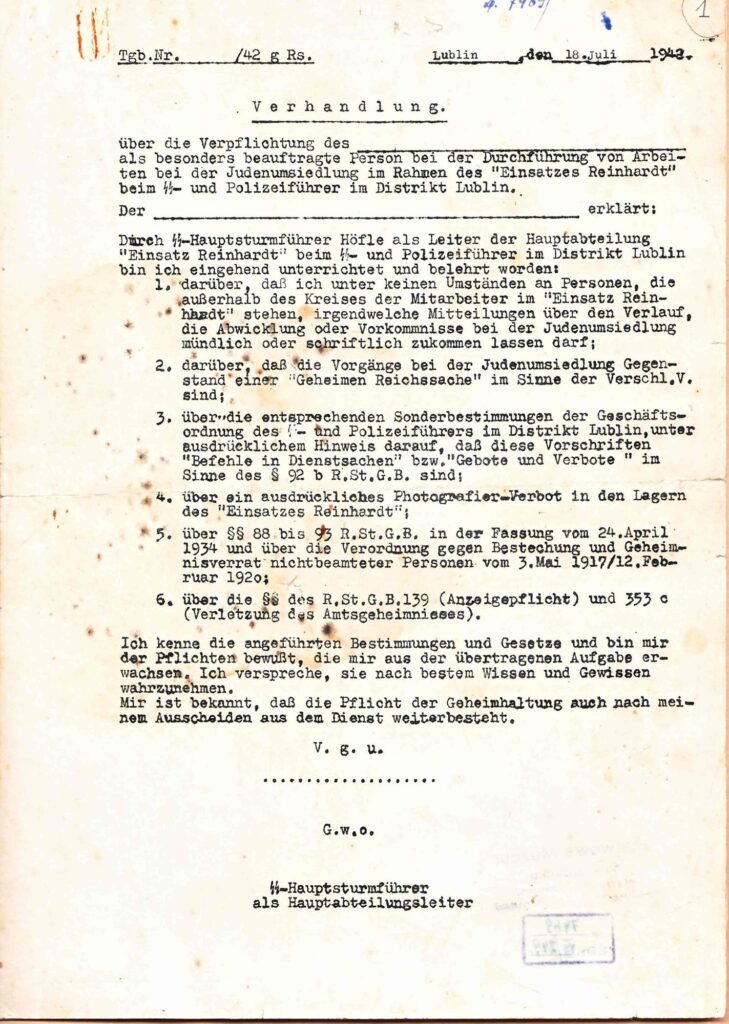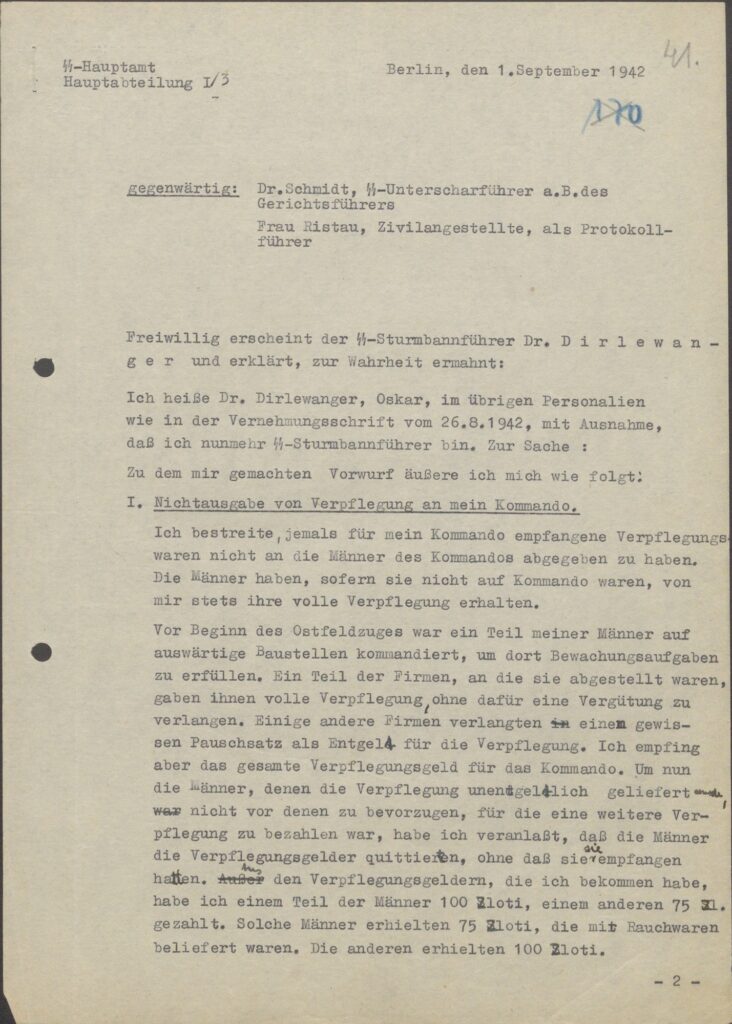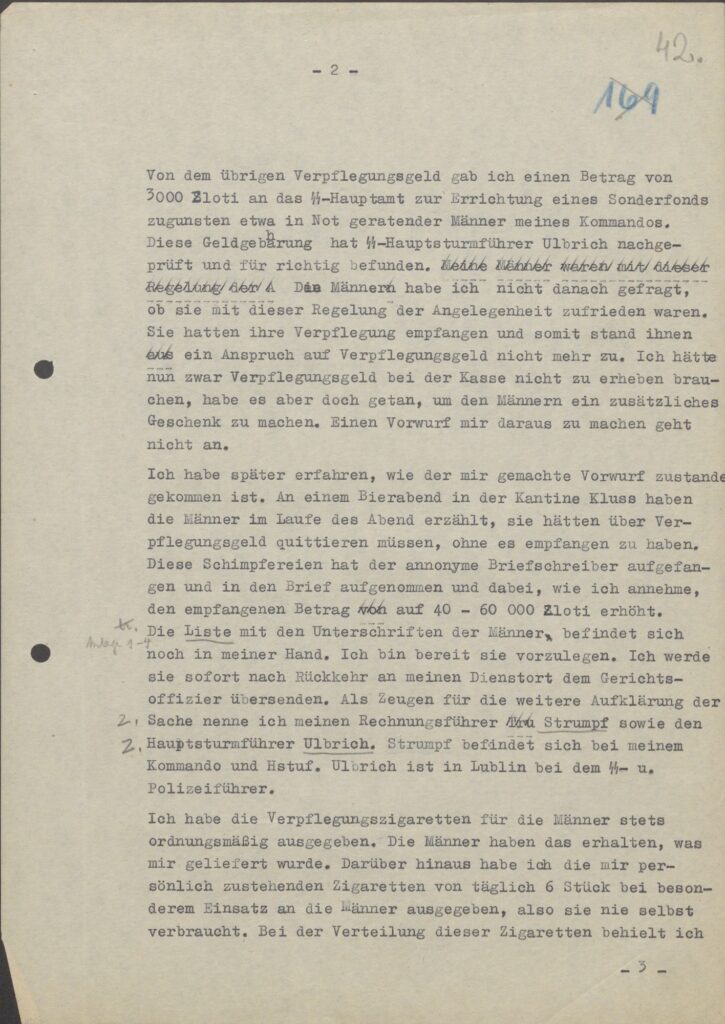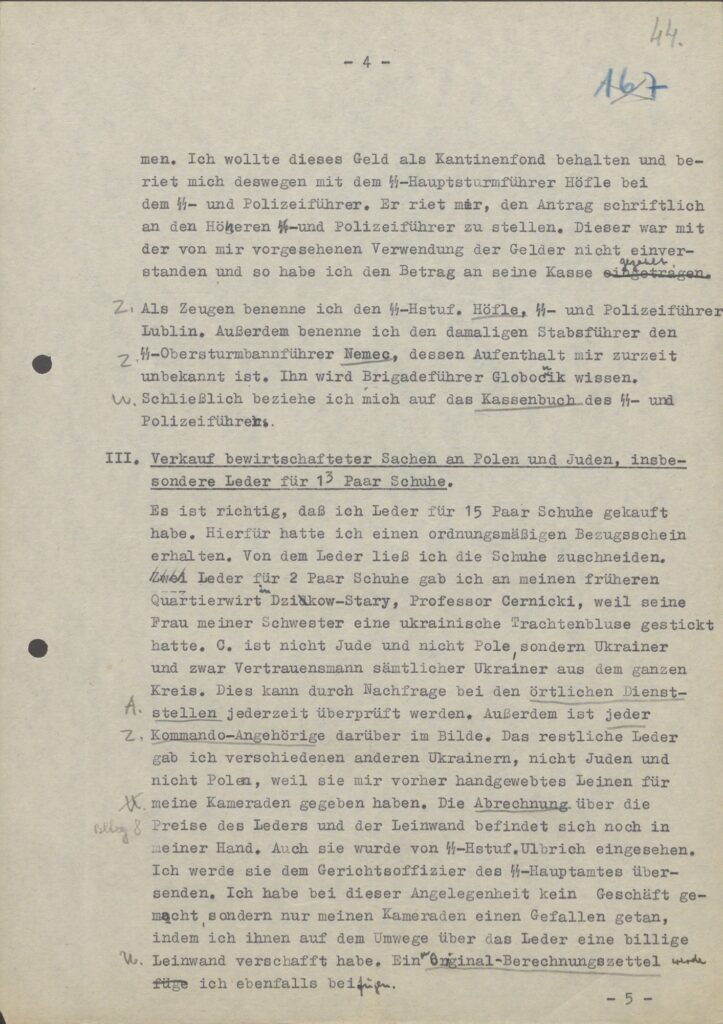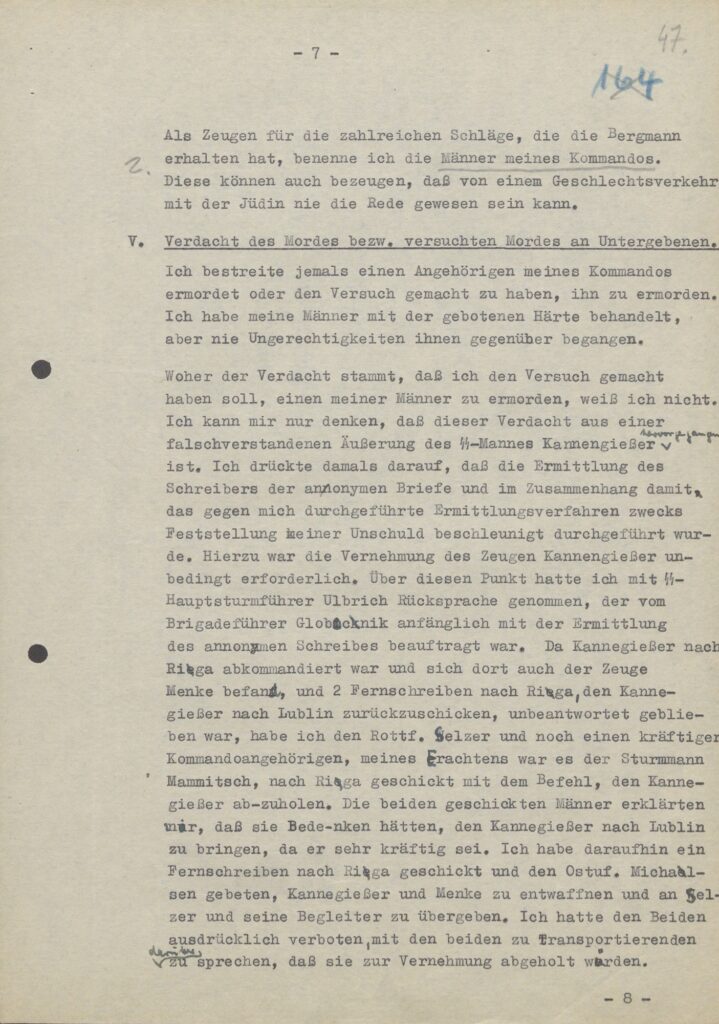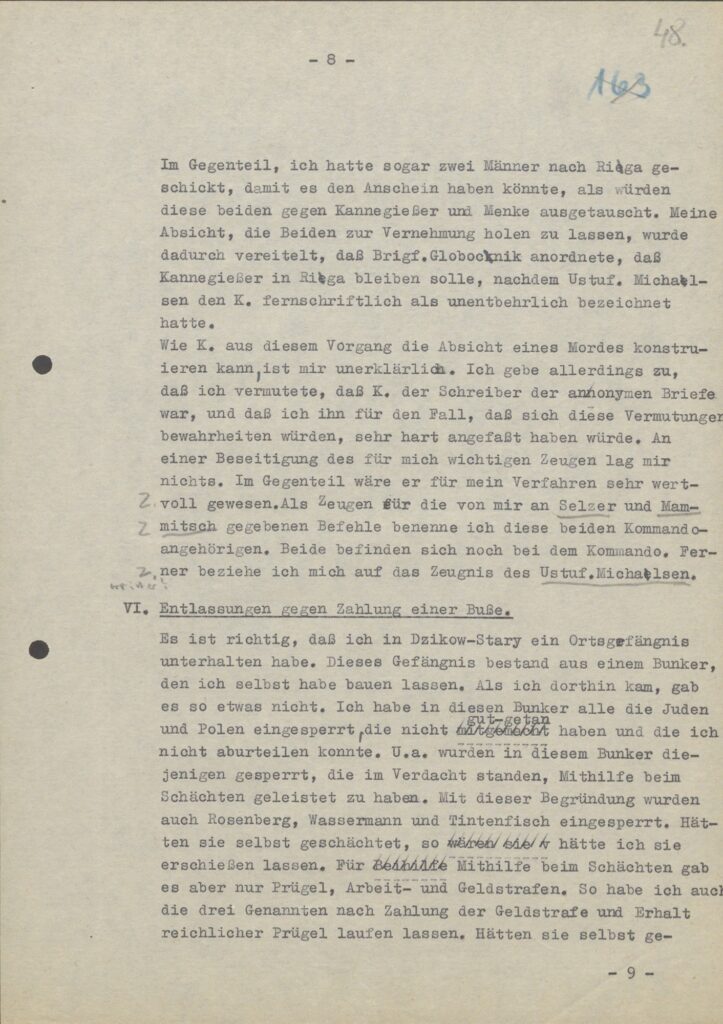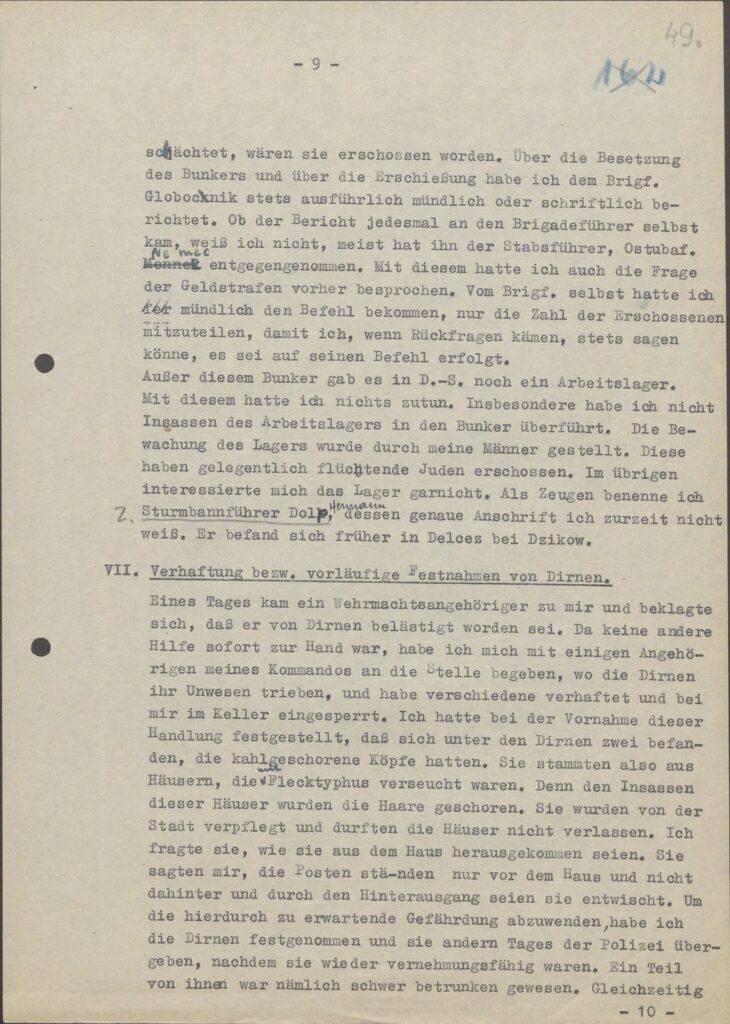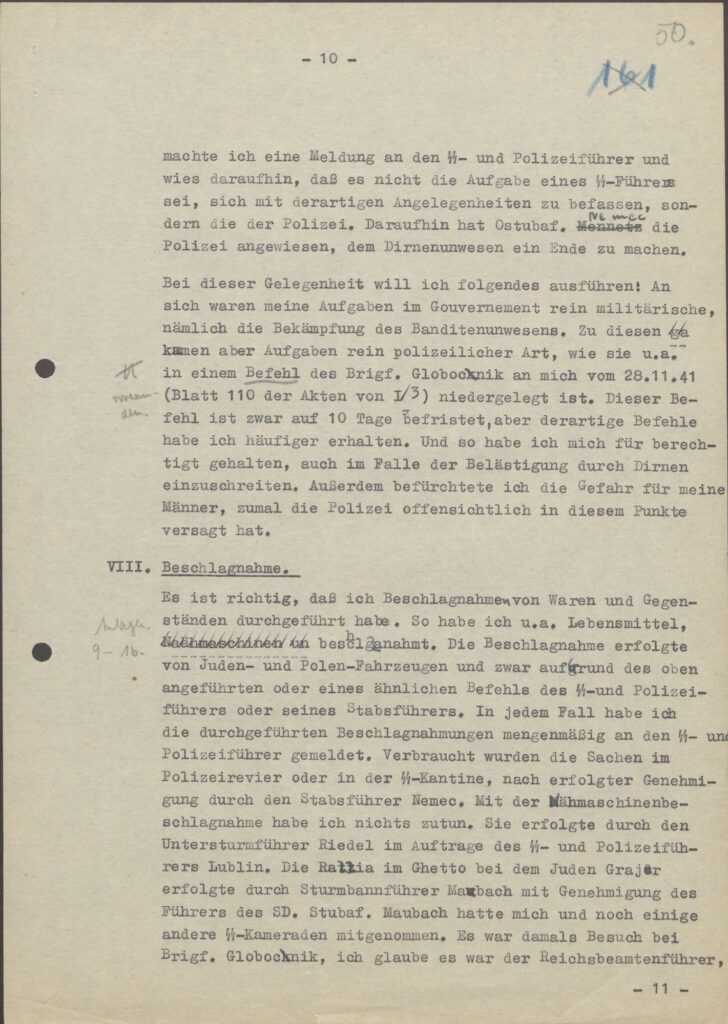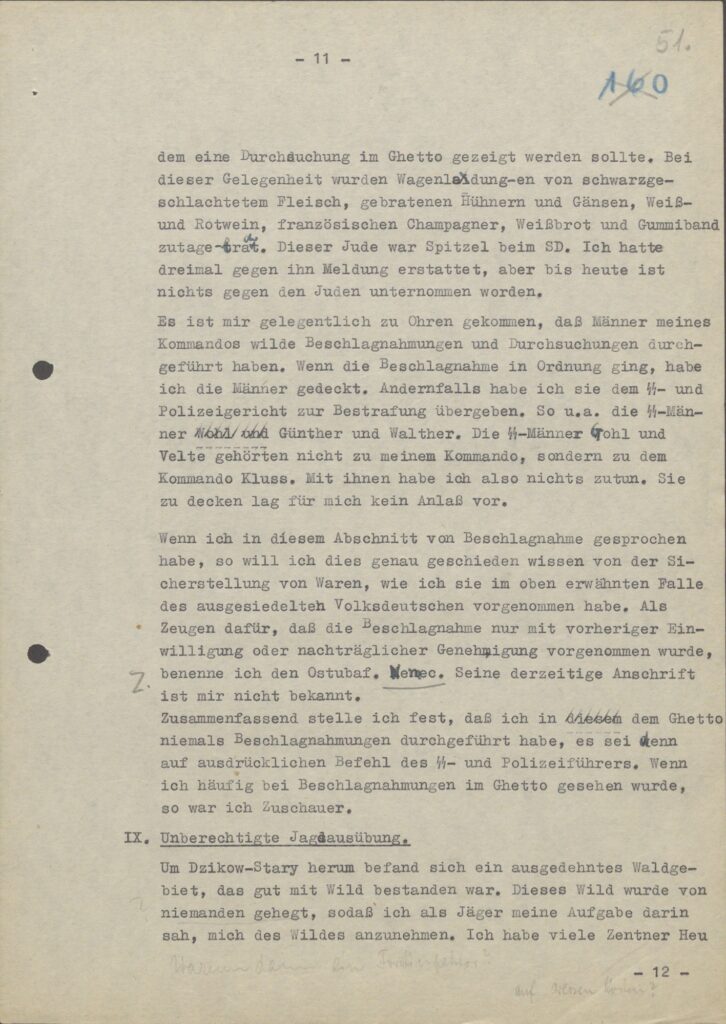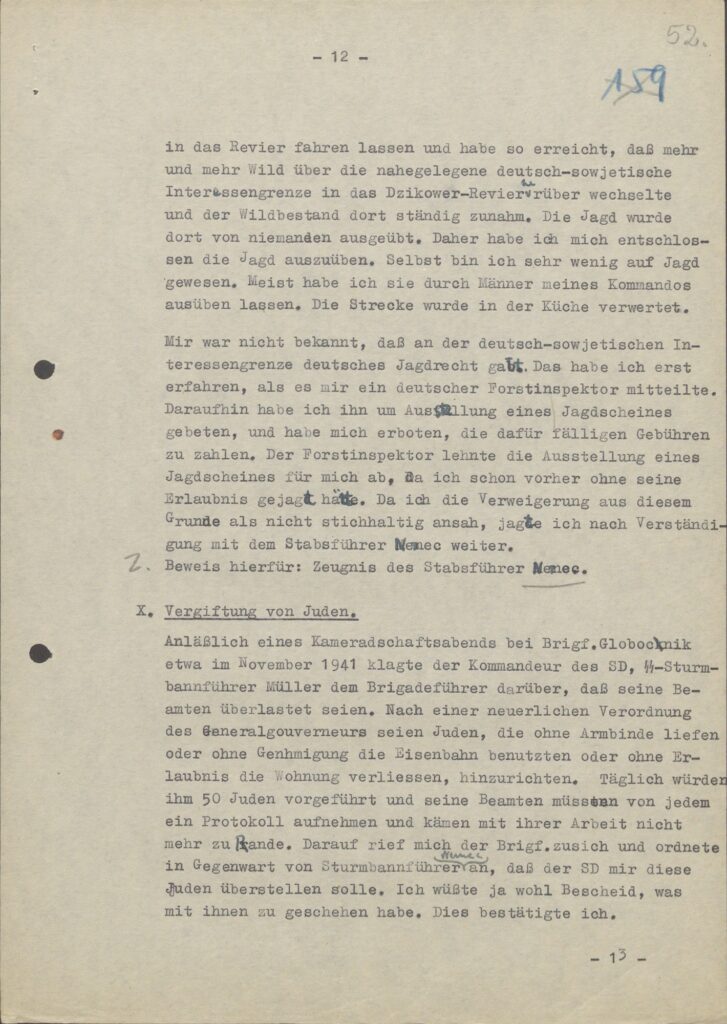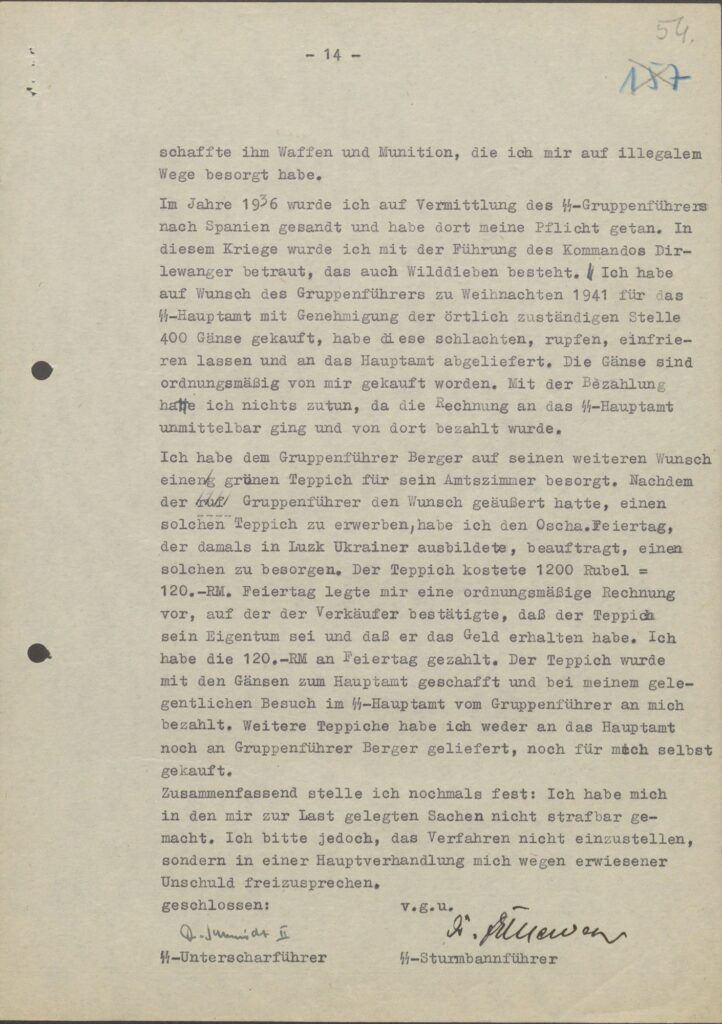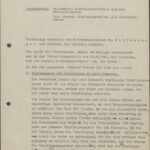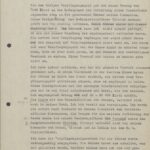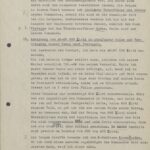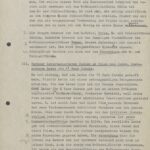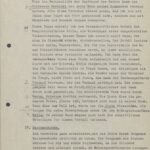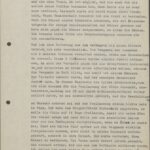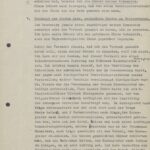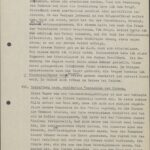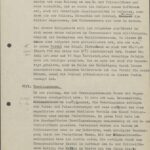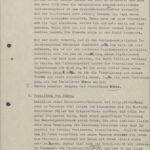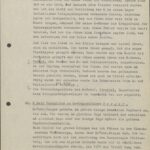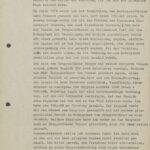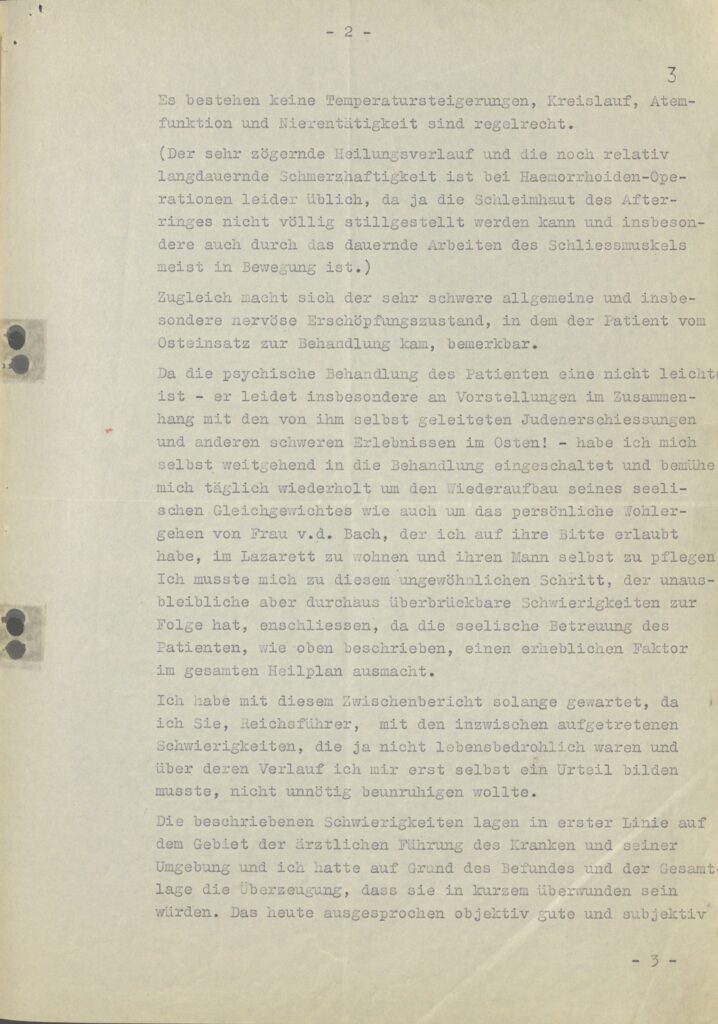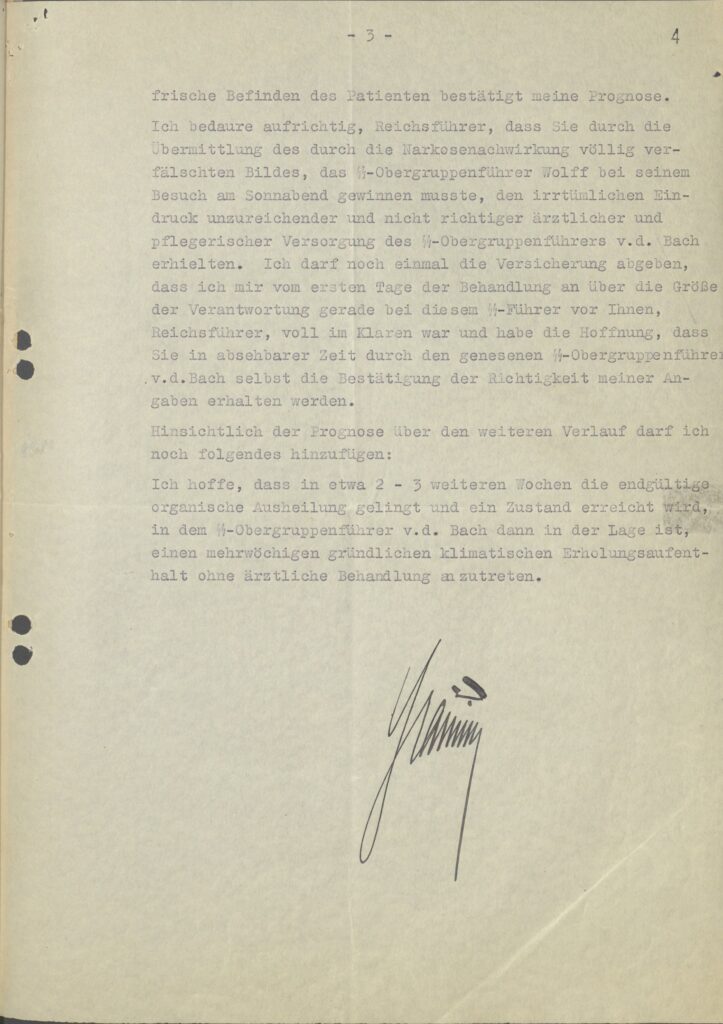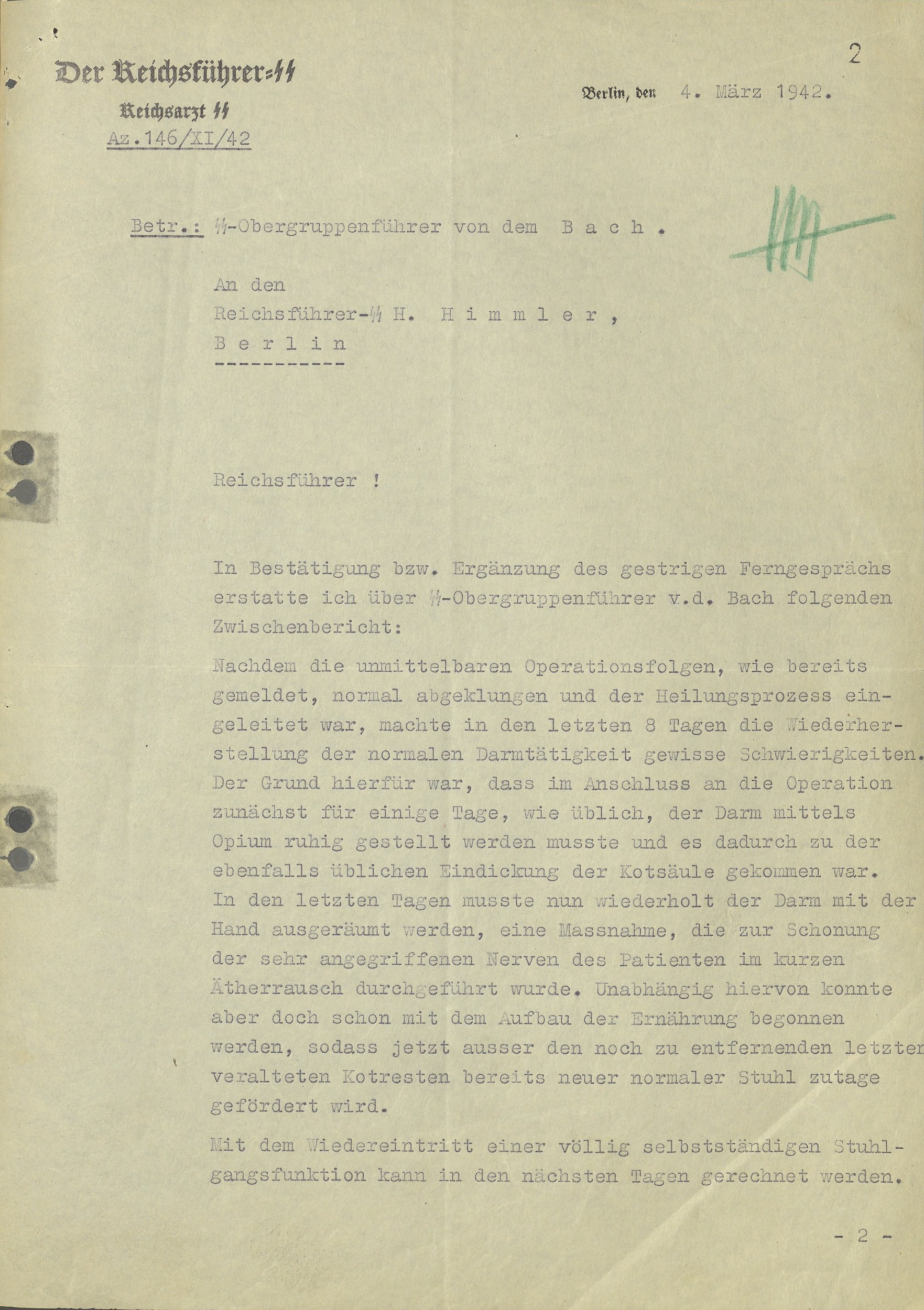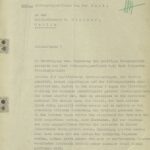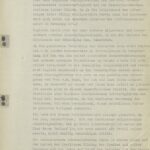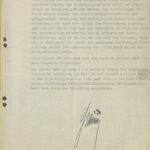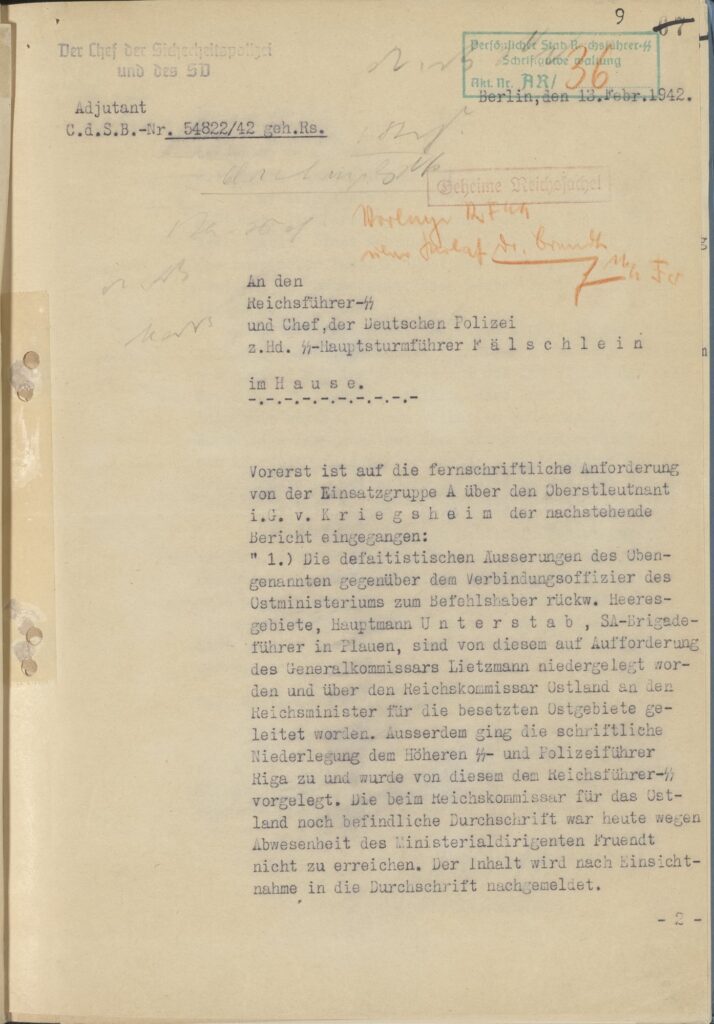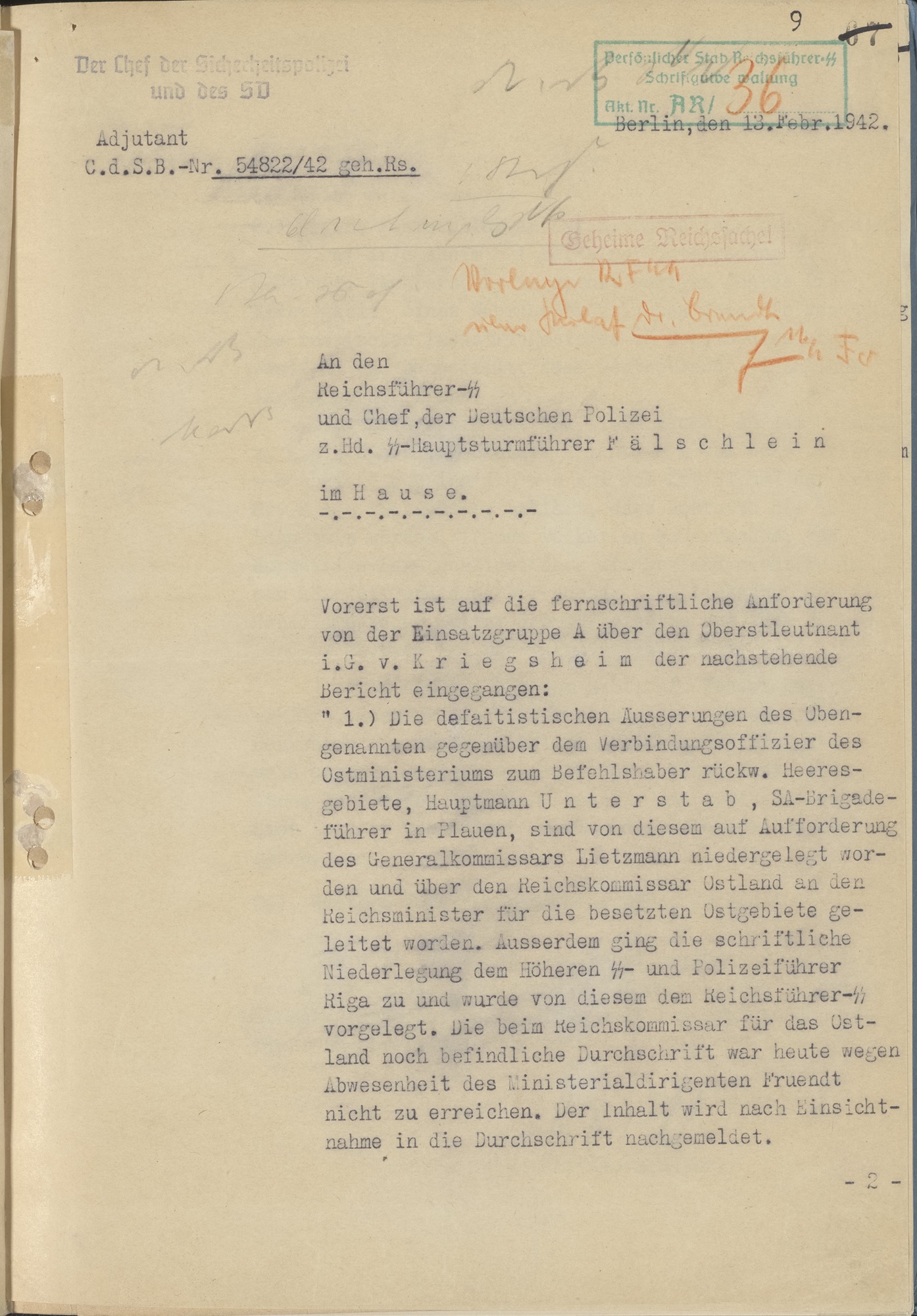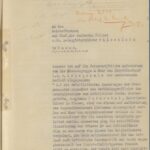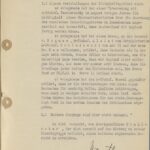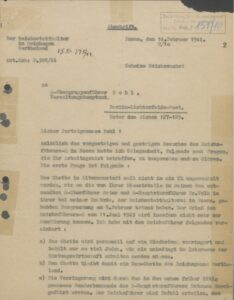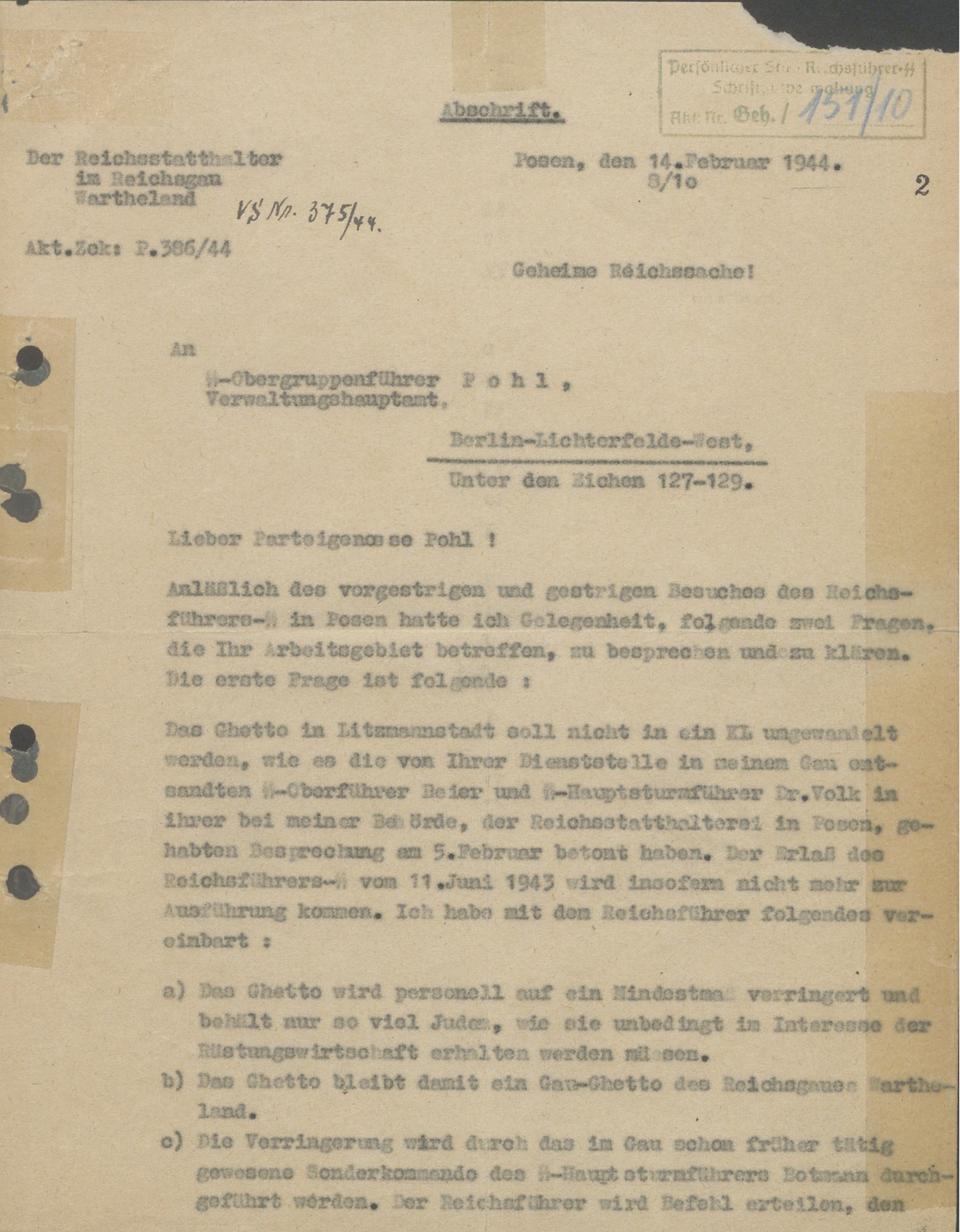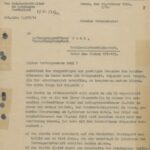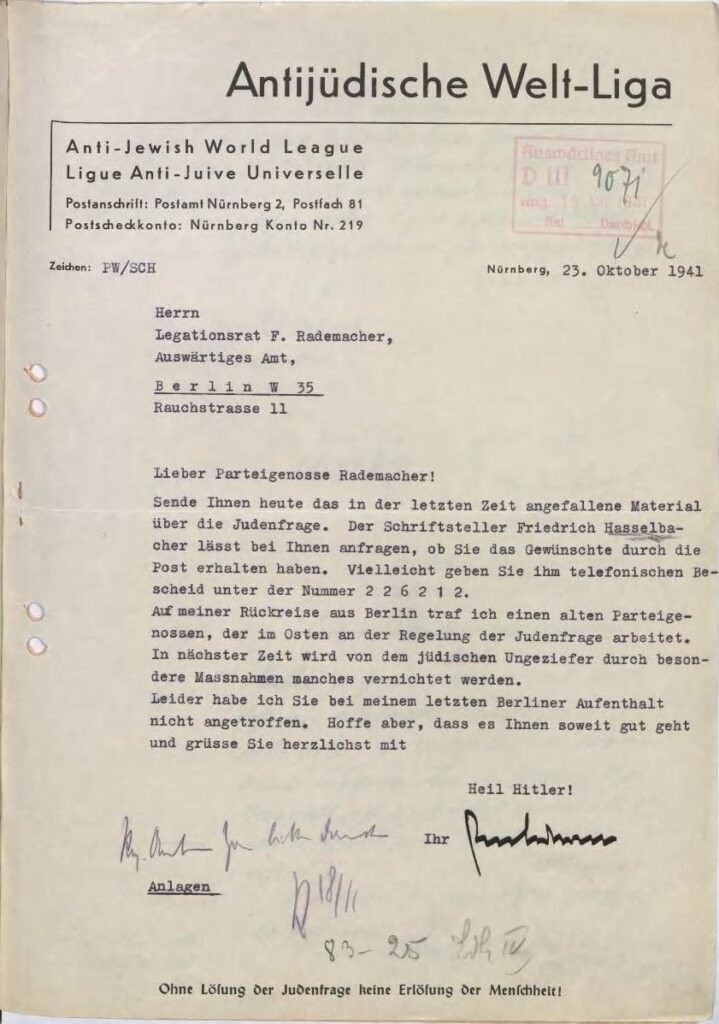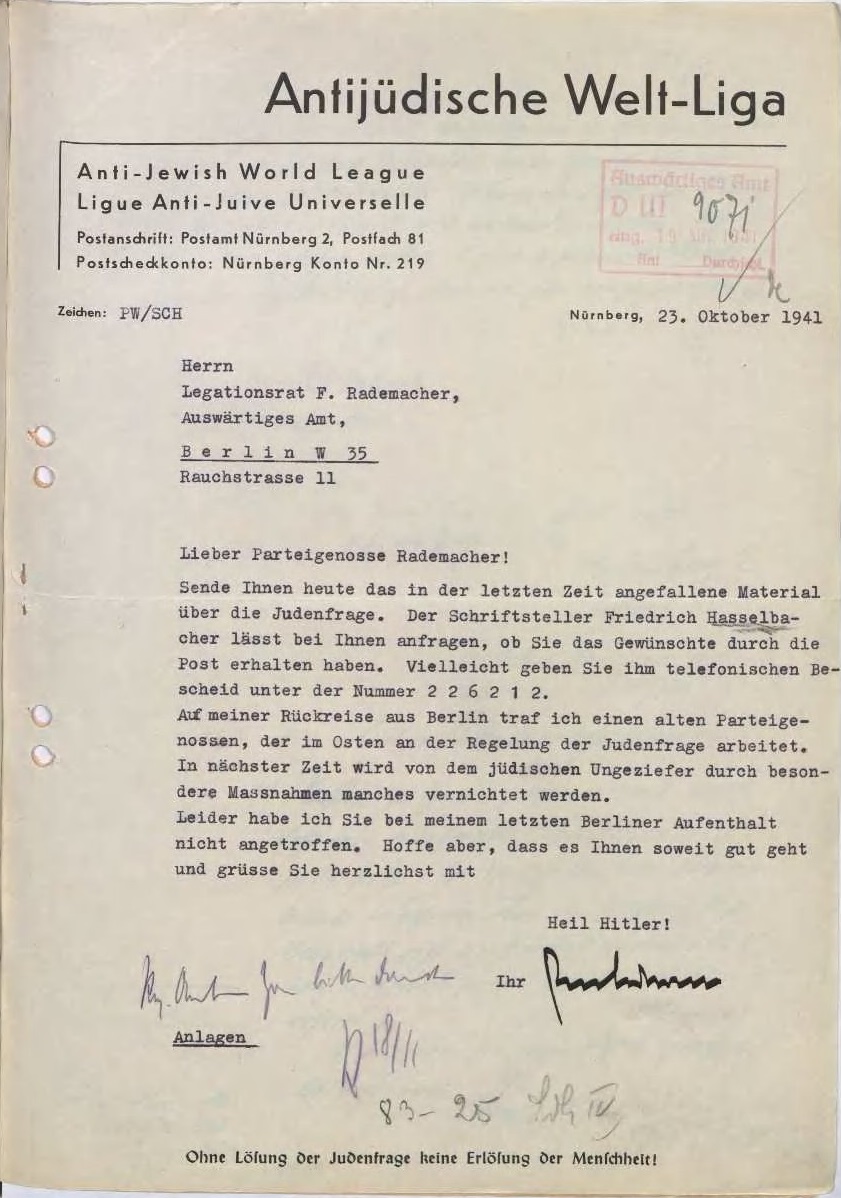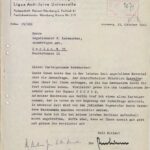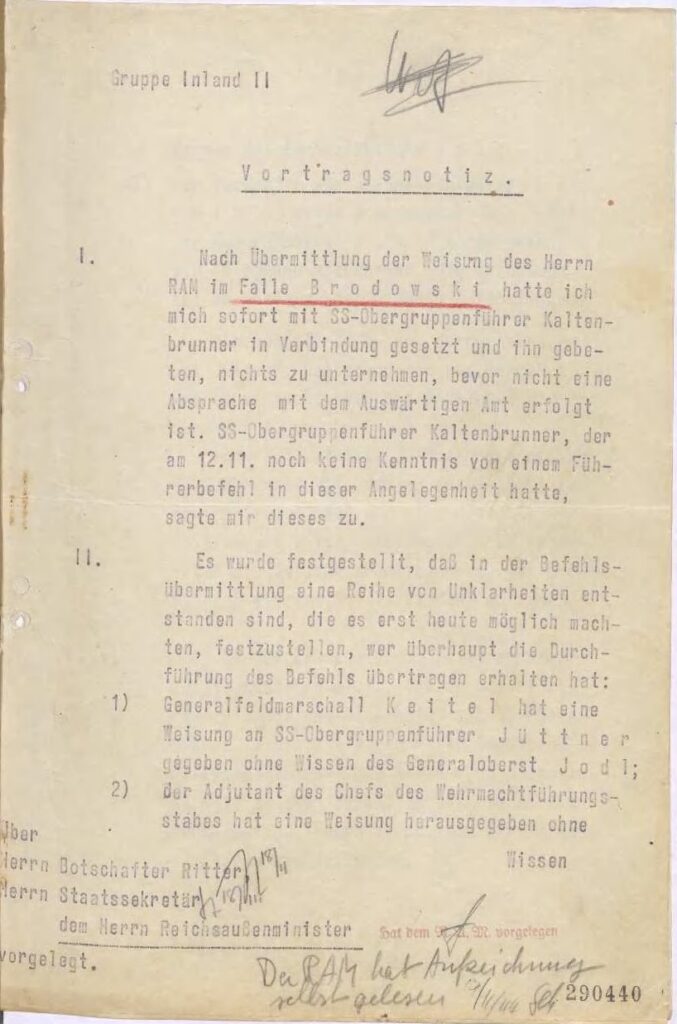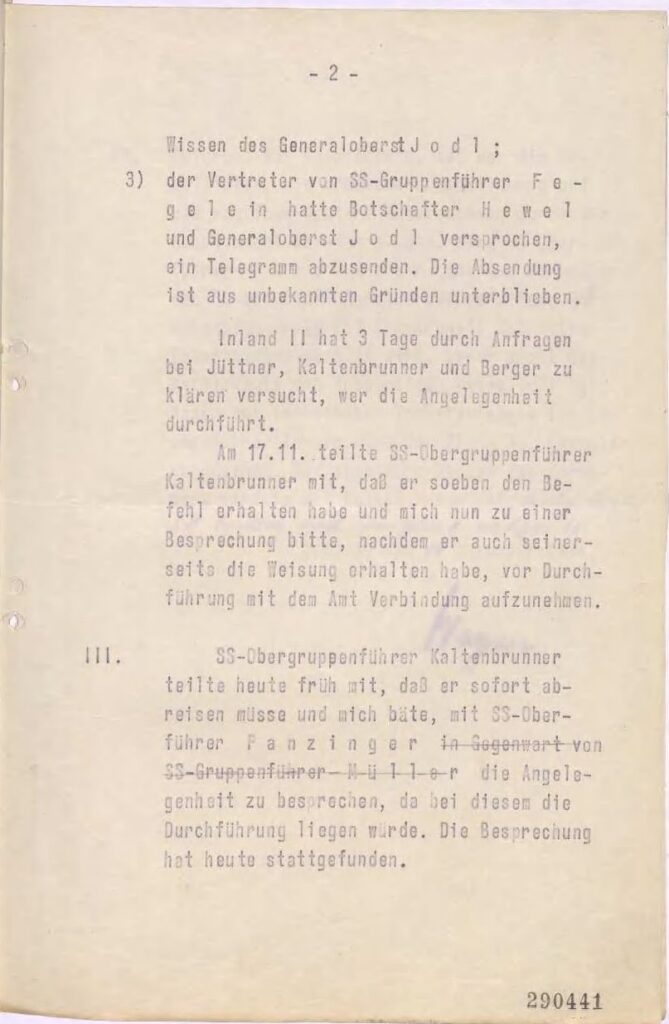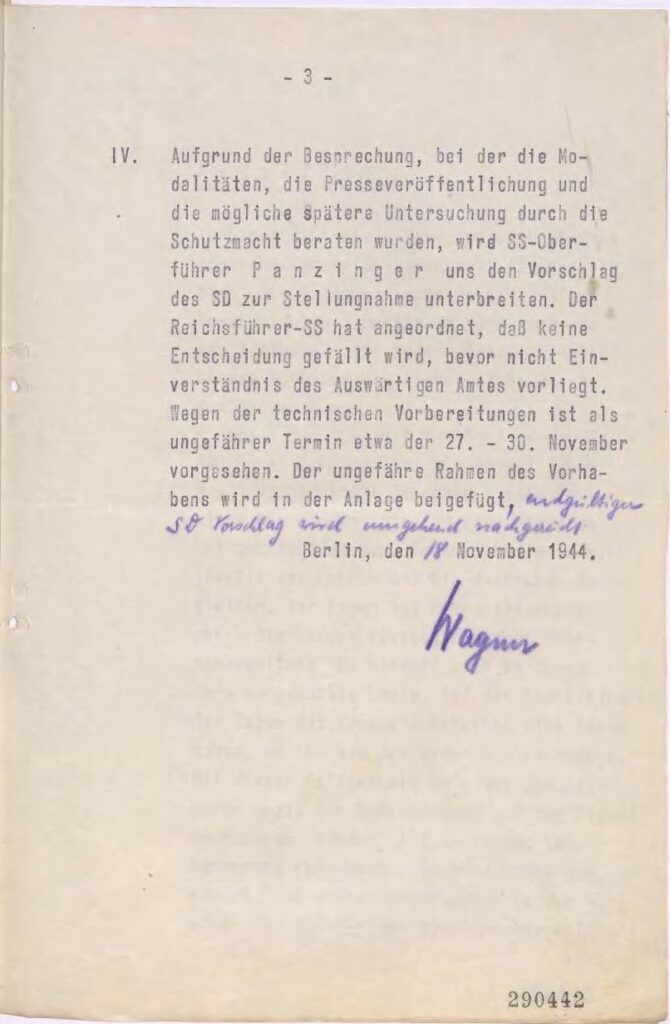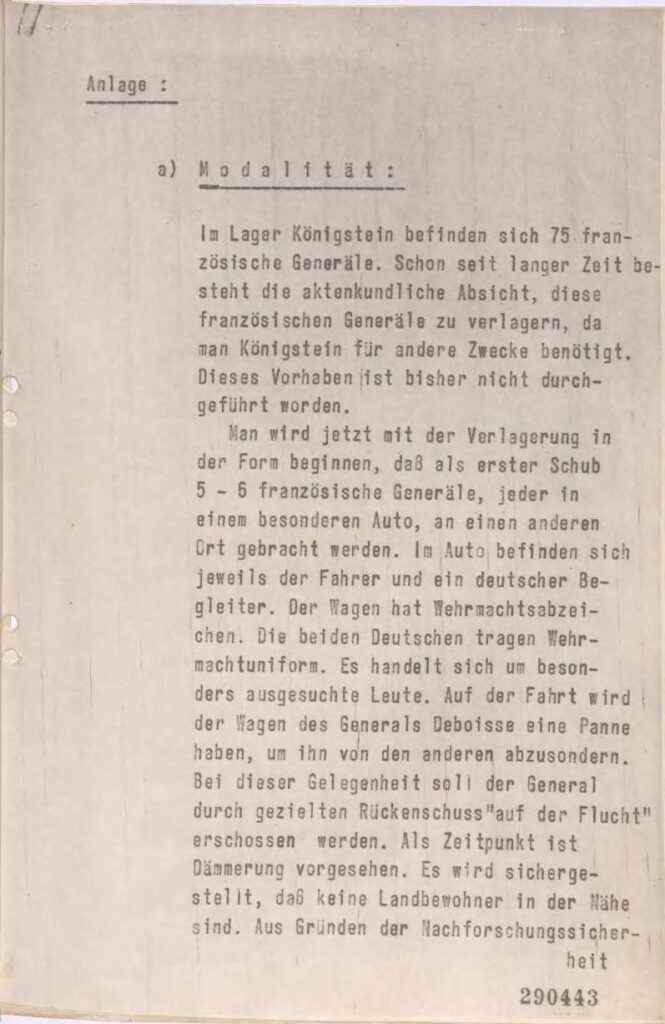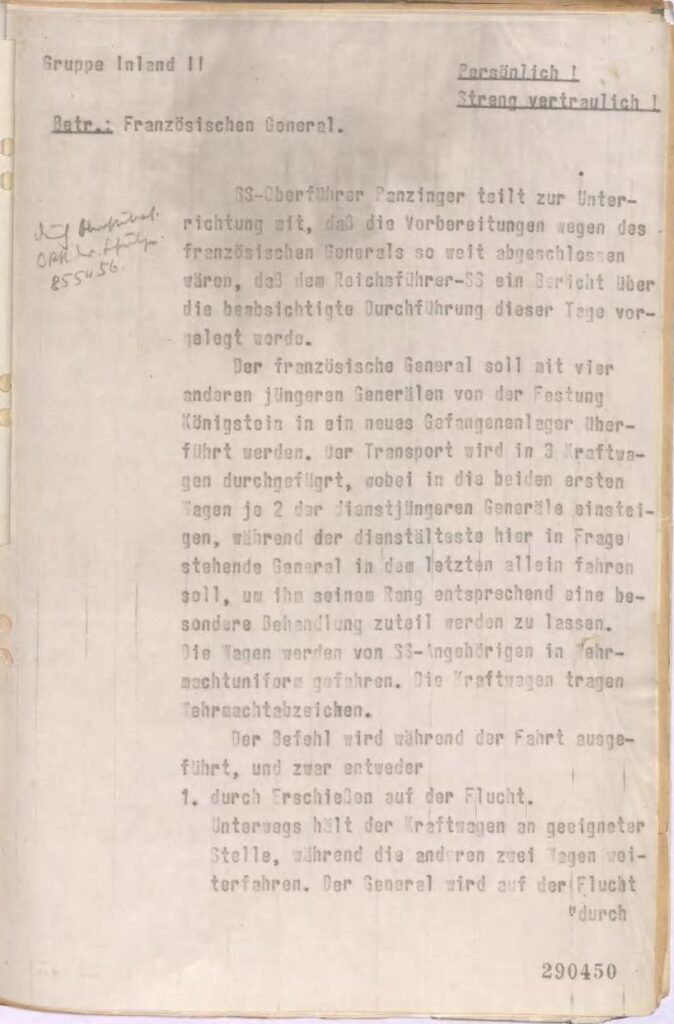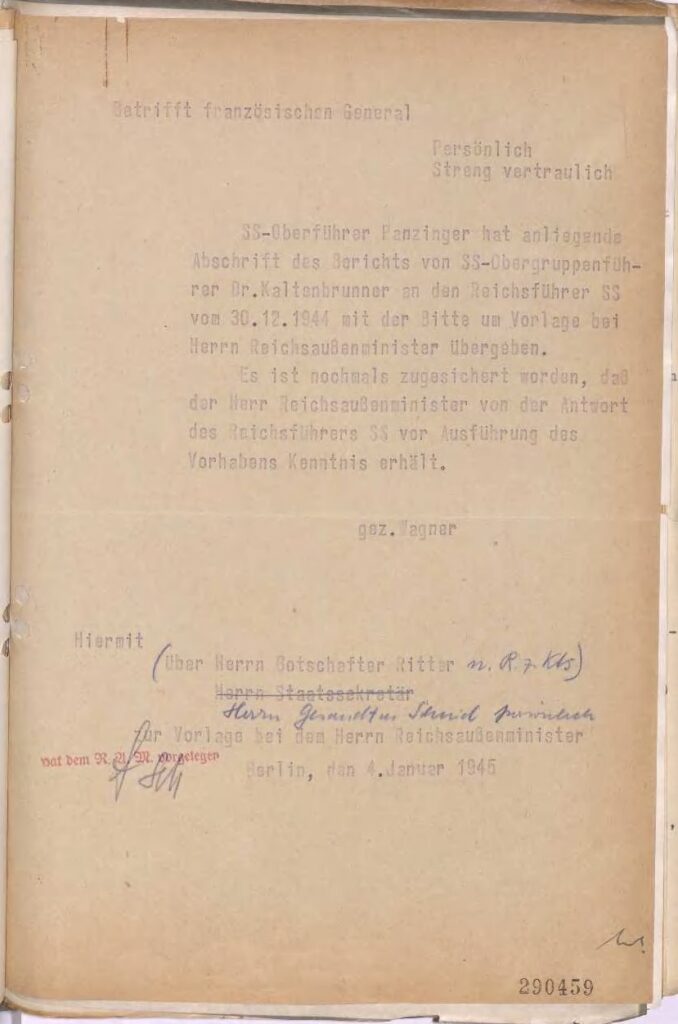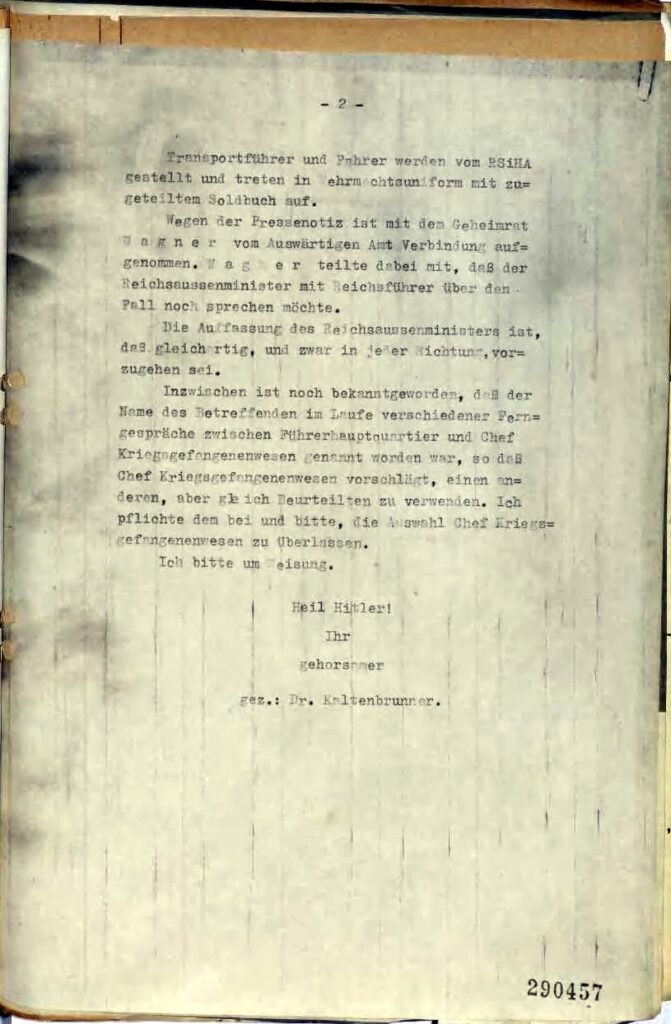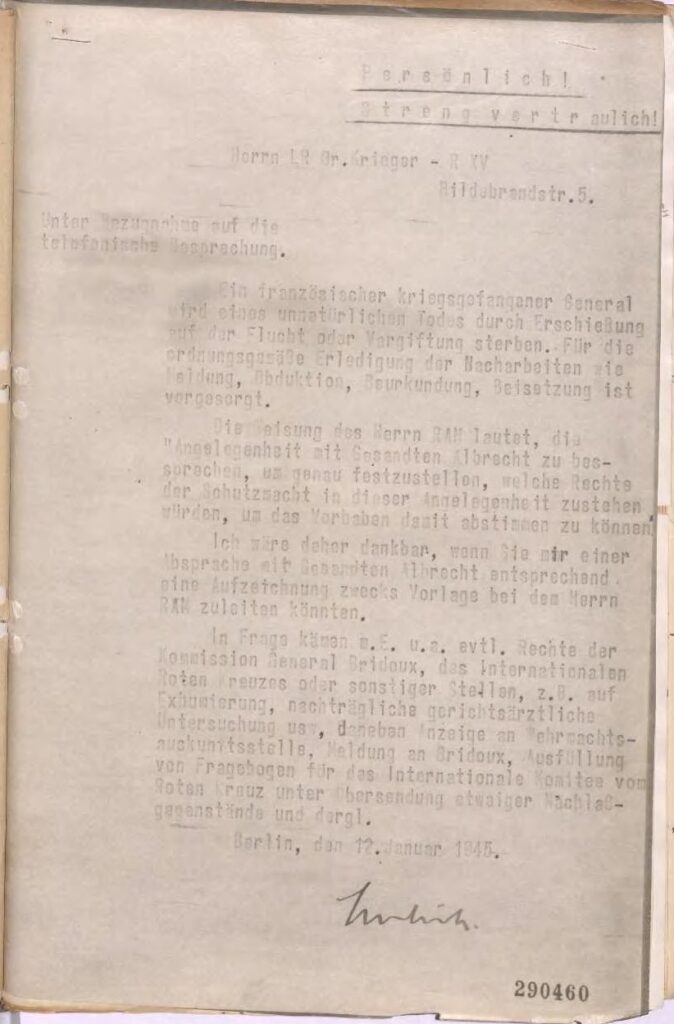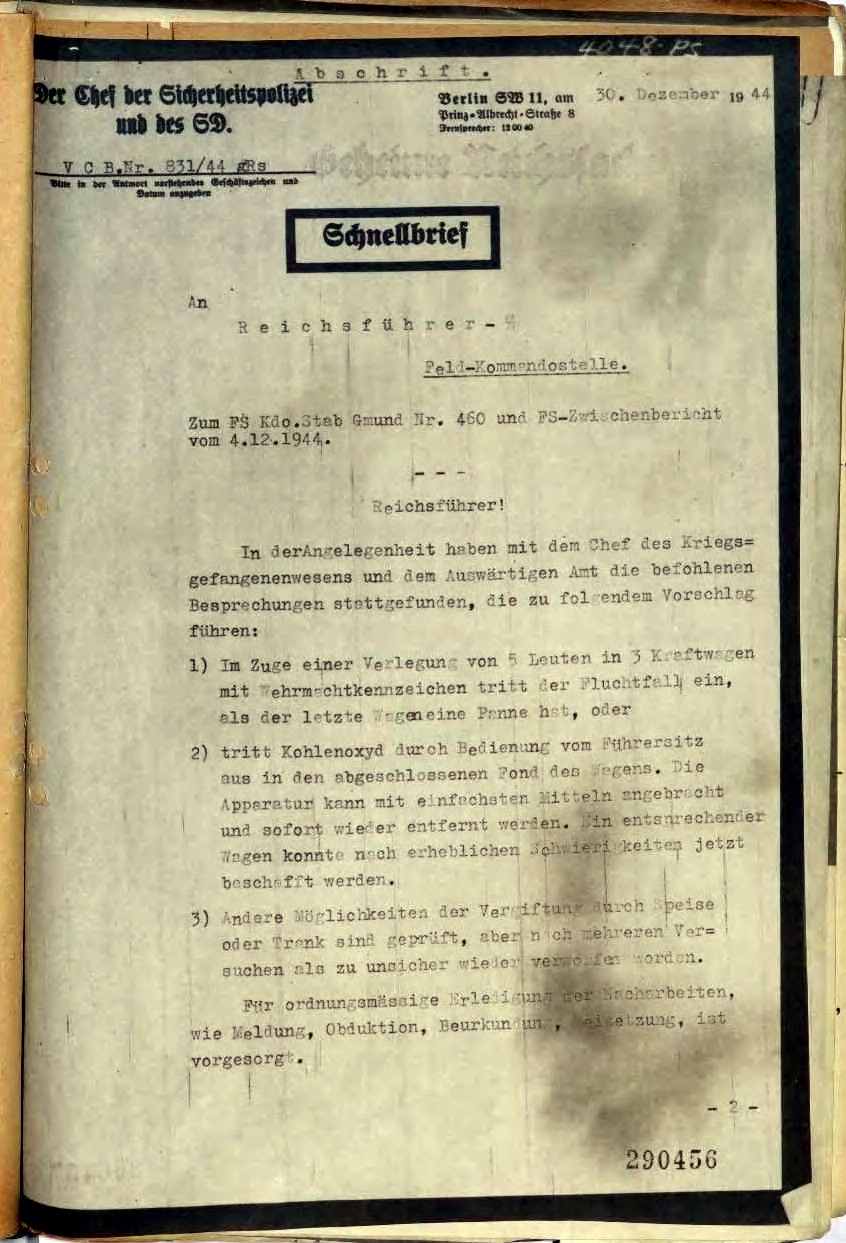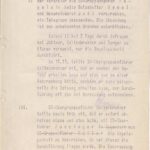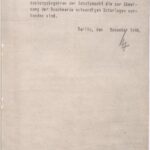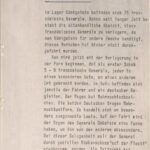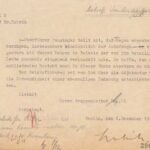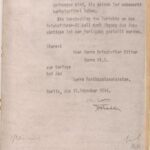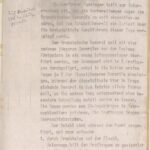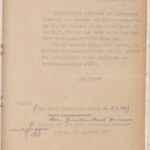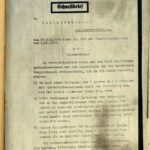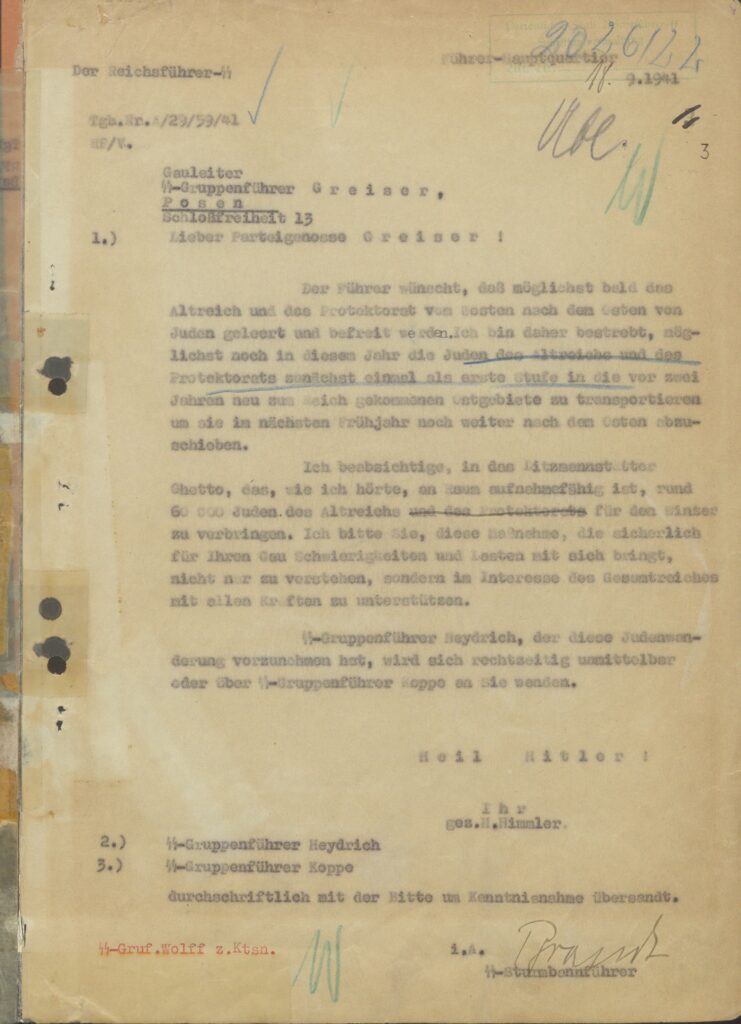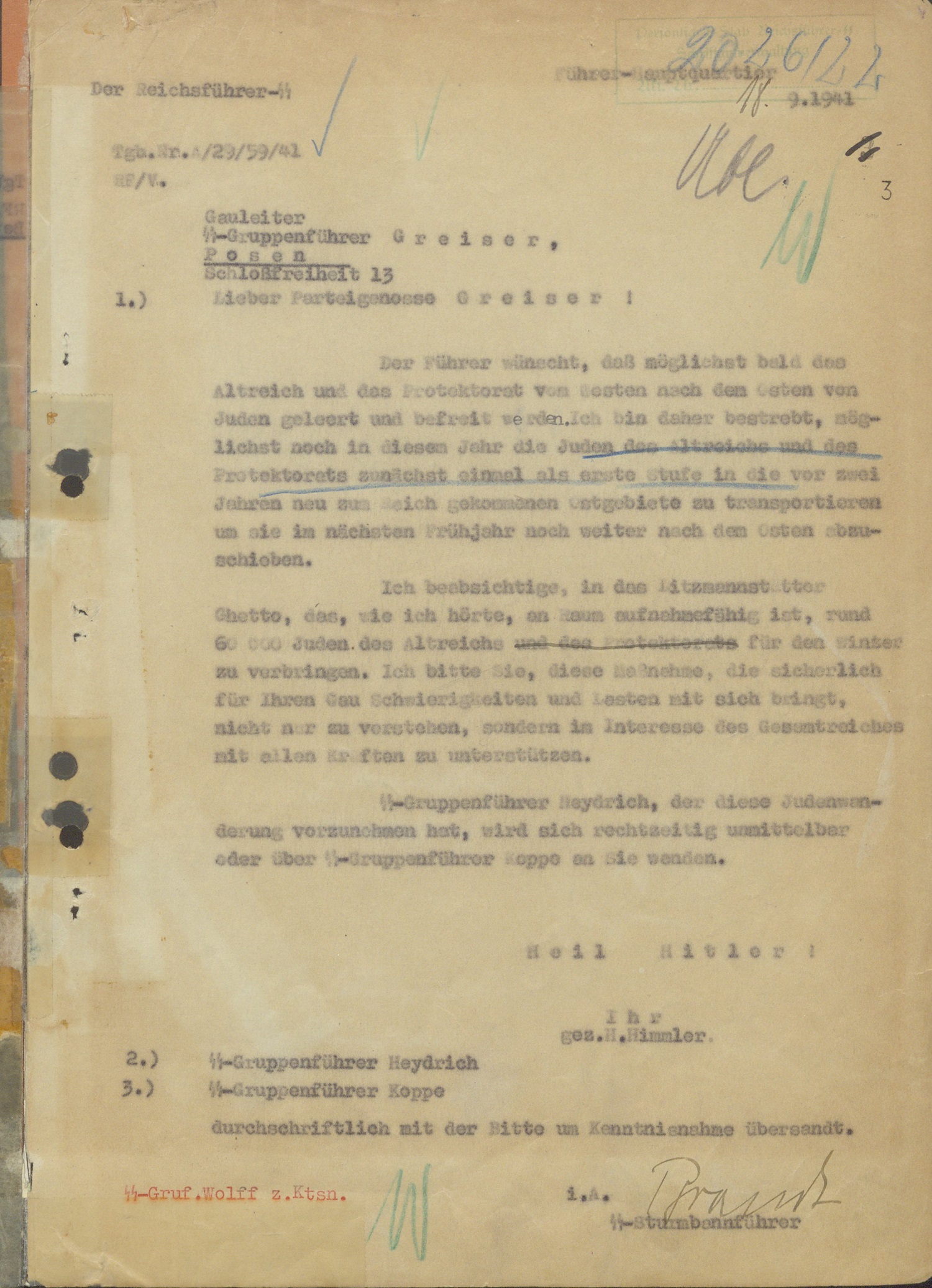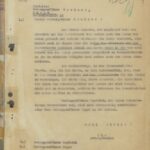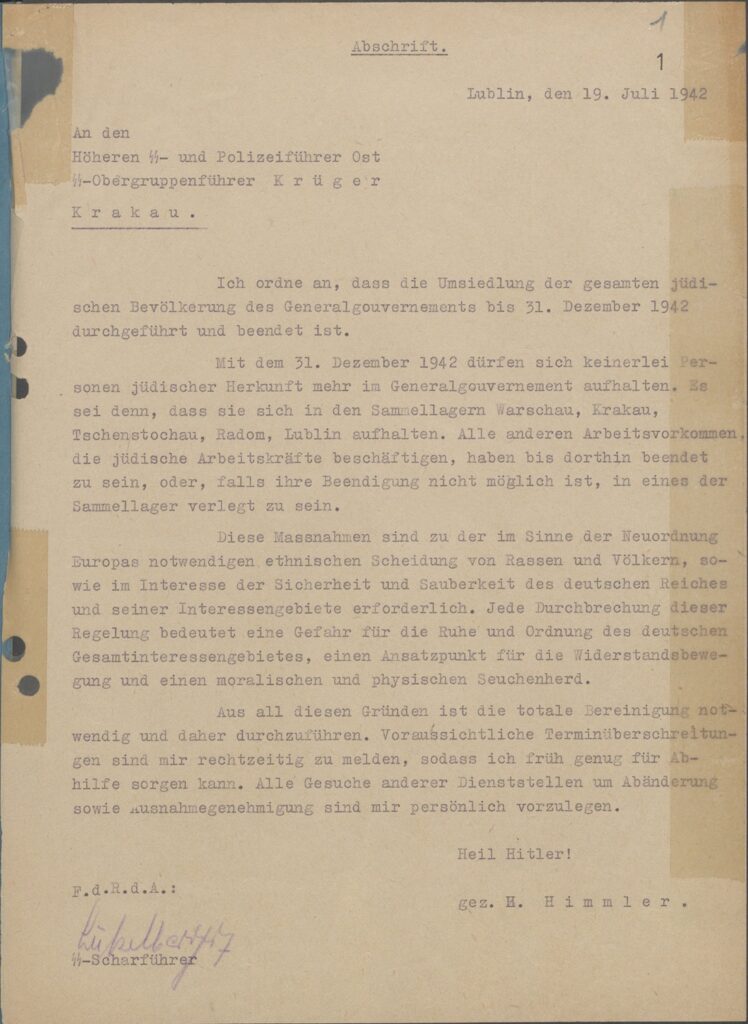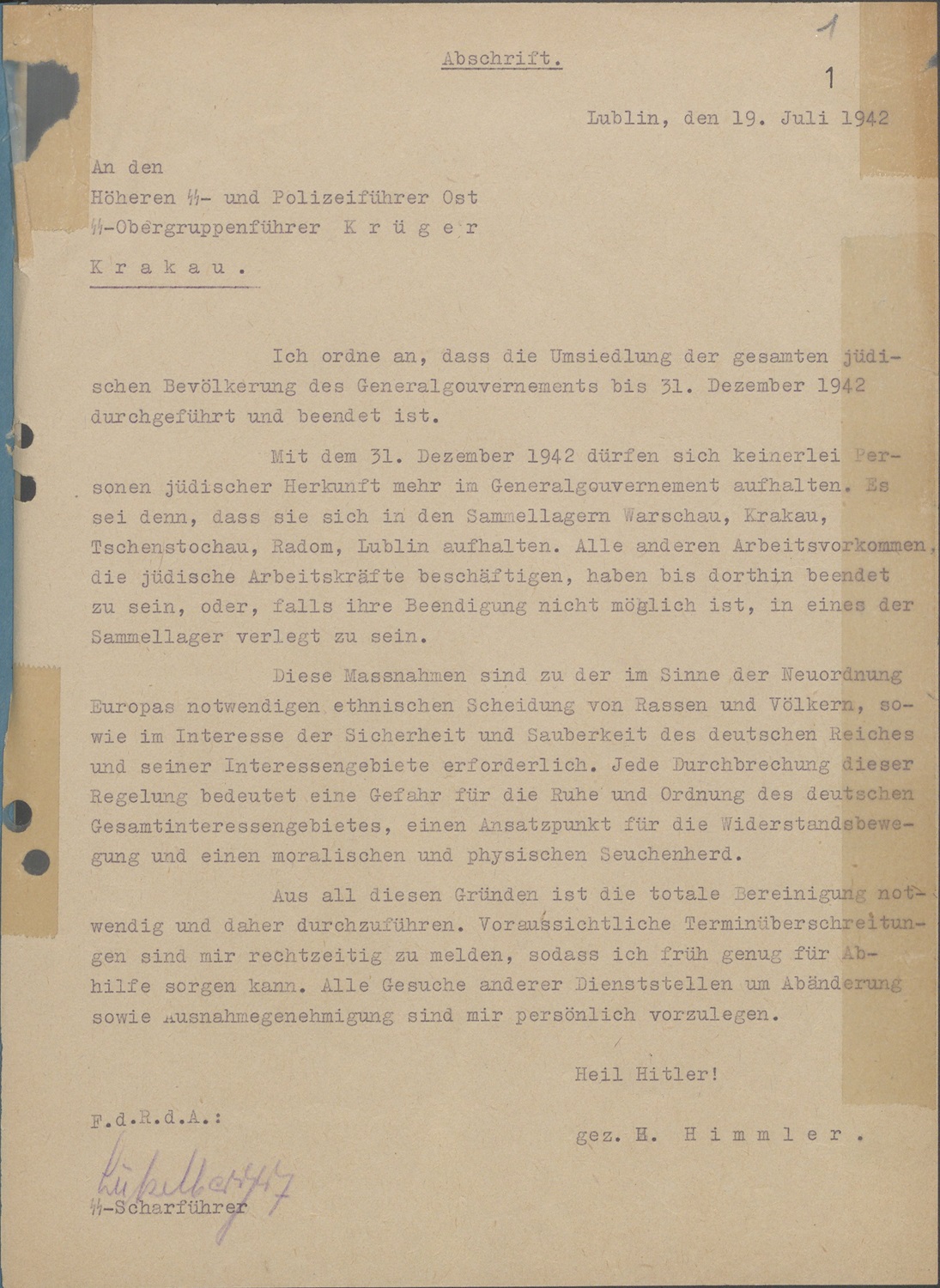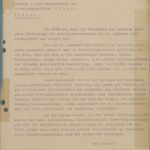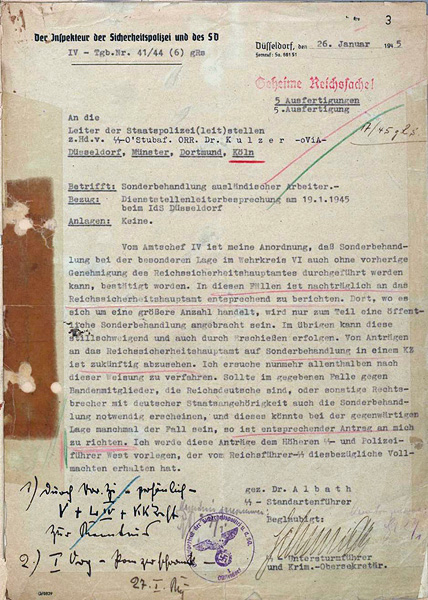SS-Hauptamt
Hauptabteilung I/3
Berlin, den 1. September 1942
gegenwärtig: Dr. Schmidt, SS-Unterscharführer a.B. des Gerichtführers
Frau Ristau, Zivilangestellte, als Protokollführer
Freiwillig erscheint der SS-Sturmbannführer Dr. Dirlewanger und erklärt, zur Wahrheit ermahnt:
Ich heiße Dr. Dirlewanger, Oskar, im übrigen Personalien wie in der Vernehmungsschrift vom 26.8.1942, mit Ausnahme, daß ich nunmehr SS-Sturmbannführer bin. Zur Sache:
Zu dem mir gemachten Vorwurf äußere ich mich wie folgt:
I. Nichtausgabe von Verpflegung an mein Kommando.
Ich bestreite, jemals für mein Kommando empfangene Verpflegung waren nicht an die Männer des Kommandos abgegeben zu haben. Die Männer haben, sofern sie nicht auf Kommando waren, von mir stets ihre volle Verpflegung erhalten.
Vor Beginn des Ostfeldzuges war ein Teil meiner Männer auf auswärtige Baustellen kommandiert, um dort Bewachungsaufgaben zu erfüllen. Ein Teil der Firmen, an die sie abgestellt waren, gaben ihnen volle Verpflegung, ohne dafür eine Vergütung zu verlangen. Einige andere Firmen verlangten eine Entschädigung von Pauschalsätzen als Entgelt für die Verpflegung. Ich empfing aber das gesamte Verpflegungsgeld für das Kommando. Um meinen Männern, denen die Verpflegung unentgeltlich – was nicht vor denen zu bevorzugen wäre, die entgeltliche Verpflegung zu bezahlen war, noch zu veranlassen, daß auch diese Verpflegungsgelder quittierten, ohne daß sie hiervon abhängig – dem Verpflegungsgeldern, die sie bekommen haben, erhielt ein Teil der Männer 100 Zloti, die anderen 75 Zloti bar. Solche Männer haben 75 Zloti, mindestens 10, während mit Rauchware beliefert waren. Die anderen erhielten 100 Zloti.
Von dem übrigen Verpflegungsgeld gab ich einen Betrag von 3000 Zloti an das SS-Hauptamt zur Errichtung eines Sonderfonds zugunsten etwa in Not geratender Männer meines Kommandos. Diese Geldgebahrung hat SS-Hauptsturmführer Ulbrich nachgeprüft und für richtig befunden. Die Männer habe ich nicht danach gefragt, ob sie mit dieser Regelung der Angelegenheit zufrieden waren. Sie hatten ihre Verpflegung empfangen und somit stand ihnen auch ein Anspruch auf Verpflegungsgeld nicht mehr zu. Ich hätte nun zwar Verpflegungsgeld bei der Kasse nicht zu erheben brauchen, habe es aber doch getan, um den Männern ein zusätzliches Geschenk zu machen. Einen Vorwurf mir daraus zu machen geht nicht an.
Ich habe später erfahren, wie der mir gemachte Vorwurf zustande gekommen ist. An einem Bierabend in der Kantine Klaus haben die Männer im Laufe des Abends erzählt, sie hätten über Verpflegungsgeld quittieren müssen, ohne empfangen zu haben. Diese Schimpfereien hat der anonyme Briefeschreiber aufgefangen und in den Brief aufgenommen und dabei, wie ich annehme, den empfangenen Betrag auf 40 – 60 000 Zloti erhöht.
Die Liste mit den Unterschriften der Männer, befindet sich noch in meinem Besitz. Ich bin bereit, sie vorzulegen. Ich werde sie sofort nach Rückkehr an meinen Dienstort dem Gerichtsoffizier übersenden. Als Zeugen für die weitere Aufklärung der Sache nenne ich meinen Rechnungsführer SS-Strumpf und den SS-Hauptsturmführer Ulbrich. Strumpf befindet sich bei meinem Kommando in Hstuf. Ulbrich ist in Lublin bei dem SS- u. Polizeiführer.
Ich habe die Verpflegungszigaretten für die Männer stets ordnungsgemäß ausgegeben. Die Männer haben das erhalten, was mir geliefert wurde. Darüber hinaus habe ich die mir persönlich zustehenden Zigaretten von täglich 6 Stück bei besonderem Einsatz an die Männer ausgegeben, also sie nie selbst verbraucht. Bei der Verteilung dieser Zigaretten behielt ich mir natürlich das Bestimmungsrecht vor. Ich würde mich darin auch von niemanden beschränken lassen. Als Zeugen in diesem Punkt benenne ich sämtliche Unterführer und Männer meines Kommandos, soweit sie sich zu der damaligen Zeit bei mir befanden. Insbesondere benenne ich die mit der Ausgabe der Rauchwaren betrauten Männer, nämlich den Koch Vieregge und den Unterscharführer Runke. Beide sind auf meinem Kommando.
II. Aneignung von 40–60 000 Zloti in strafbarer Weise und Verbringung dieser Summe nach Stuttgart.
Ich bestreite den Vorwurf; ich habe nie 40–60 000 Zloti besessen.
Wie ich bereits früher erklärt habe, schickte ich meiner Mutter monatlich 150 RM von meinem Wehrsold. Hatte ich außer dieser Summe mal etwas erübrigt, z.B. wenn ich mich in Gegenden befand, wo es keine Möglichkeit gab, Geld auszugeben, so war ich in der Lage, auch Beträge auf mein Konto in Stuttgart einzuzahlen, indem ich es Urlaubern mitgab. Dies ist in zwei oder drei Fällen geschehen.
Jeder Urlauber war berechtigt, 600 Zloti einzutauschen. Fuhr nun ein Angehöriger des Kommandos in Urlaub und hatte er, wie ich auf Befragen festgesetzt hatte, keine 600 Zloti eigenes Geld, so gab ich ihm aus meinem Gelde einen Betrag, der so bemessen war, dass der Betrag von 600 Zloti nicht überschritten wurde und der Urlauber das Geld für mich einwechseln und auf mein Konto einzahlen konnte. Dies ist wie oben gesagt zwei- oder dreimal geschehen und es handelt sich jeweils um Beträge von 200 bis 400 Zloti.
Als Zeugen hierfür benenne ich den SS-Schützen Kannengiesser. Ob ich noch einem anderen Angehörigen des Kommandos Geld mitgegeben habe, weiß ich nicht mehr.
Strafgelder oder aus ähnlichen Gründen entstandene Gelder habe ich nicht auf mein eigenes Konto eingezahlt. Diese Gelder habe ich vielmehr an die Kasse des SS- und Polizeiführers abgeführt. Einmal hatte ich 1500 Zloti an Strafgeldern eingenommen. Ich wollte dieses Geld als Kantinenfond behalten und beriet mich deswegen mit dem SS-Hauptsturmführer Höfle bei dem SS- und Polizeiführer. Er riet mir, den Antrag schriftlich an den Höheren SS- und Polizeiführer zu stellen. Dieser war mit der von mir vorgesehenen Verwendung der Gelder nicht einverstanden und so habe ich den Betrag an seine Kasse gezahlt.
Als Zeugen benenne ich den SS-Hstuf. Höfle, SS- und Polizeiführer Lublin. Außerdem benenne ich den damaligen Stabsführer, den SS-Obersturmbannführer Nemec, dessen Aufenthalt mir zurzeit unbekannt ist. Ihn wird Brigadeführer Globocnik wissen. Schließlich beziehe ich mich auf das Kassenbuch des SS- und Polizeiführers.
III. Verkauf bewirtschafteter Sachen an Polen und Juden, insbesondere Leder für 13 Paar Schuhe.
Es ist richtig, dass ich Leder für 15 Paar Schuhe gekauft habe. Hierfür hatte ich einen ordnungsgemäßen Bezugsschein erhalten. Von dem Leder ließ ich die Schuhe zuschneiden. Leder für 2 Paar Schuhe gab ich an meinen früheren Quartierwirt in Dzidkow-Stary, Professor Cernicki, weil seine Frau meiner Schwester eine ukrainische Trachtenbluse gestickt hatte. C. ist nicht Jude und nicht Pole, sondern Ukrainer und Vertrauensmann sämtlicher Ukrainer aus dem ganzen Kreis. Dies kann durch Nachfrage bei der örtlichen Dienststelle jederzeit überprüft werden. Außerdem ist jeder Kommando-Angehörige darüber im Bilde. Das restliche Leder gab ich verschiedenen anderen Ukrainern, nicht Juden und nicht Polen, weil sie mir vorher handgewebtes Leinen für meine Kameraden gegeben hatten. Die Abrechnung über die Preise des Leders und der Leinwand befindet sich noch in meiner Hand. Auch sie wurde vom SS-Hstuf. Ulbrich eingesehen. Ich werde sie dem Gerichtsoffizier des SS-Hauptamtes übersenden. Ich habe bei dieser Angelegenheit kein Geschäft gemacht sondern nur meinen Kameraden einen Gefallen getan, indem ich ihnen auf dem Umwege über das Leder eine billige Leinwand verschafft habe, Einen Original-Berechnungszettel werde ich ebenfalls beifügen.
Über die Nationalität der Empfänger des Leders kann der Professor Cernicki und jeder Mann meines Kommandos Aussage machen. Alle diese Personen wissen genau, daß ich nie mit Juden oder Polen ein Wort gesprochen habe, sondern nur mit Ukrainern und Männern meines Kommandos.
Eines Tages erhielt ich den fremdschriftlichen Befehl des Hauptsturmführers Höfle, ein Warenlager eines ausgesiedelten Volksdeutschen, dessen Namen ich zurzeit nicht weiß, der aber in Cizanow wohnte, sicherzustellen. Der Befehl lautete weiter dahin, Gegenstände, die für die Dienststelle des SS- und Polizeiführers brauchbar waren, an diese abzuliefern, die übrigen aber verkaufen zu lassen. Ich habe über die verhandelten Waren eine Liste aufgestellt und aus dieser Liste hat der SS-Hstuf. Höfle die diejenigen Waren bezeichnet, die für die Dienststelle in Frage kamen, und diejenigen die ich verkaufen lassen konnte. Als Käufer kamen nur Ukrainer in Frage, nicht Polen und Juden, das kann der Rechnungsführer Strumpf bezeugen, der den Verkauf getätigt hat. Das eingegangene Geld wurde an Hstuf. Höfle abgeliefert und zwar durch mich persönlich. Die abzuliefernde Ware wurde durch Uscha. Schwippe dorthin verbracht. Die Liste über die gesamten Waren, glaube ich, befindet sich noch in meiner Hand. Wenn dies der Fall ist, werde ich die Liste übersenden. Als Zeugen für meine Behauptungen nenne ich den SS-Hauptsturmführer Höfle. In seiner Hand müßten sich noch die schriftlichen Unterlagen für diesen Vorfall befinden.
IV. Rassenschande.
Ich bestreite ganz entschieden, mit der Jüdin Sarah Bergmann Rassenschande getrieben zu haben. Die Bergmann war Küchenmädchen bei mir und wurde hilfsweise, da sie fließend deutsch und polnisch sprach, zu Dolmetscherdiensten herangezogen. Die Bergmann wurde von mir als das behandelt, was sie war, nämlich eine Jüdin, die für mich die niedersten Arbeiten zu tun hatte. Es ist richtig, daß sie oft geschlagen worden ist, das geschah aber in meinem Auftrag durch meine Männer und nie ohne Grund. Es ist möglich, daß sie auch von mir selbst schon Schläge bekommen hat, dann hatte sie es aber auch verdient. Bestraft wurde sie meist wegen ihrer Frechheit. Wegen Unsauberkeit brauchte ich sie nicht zu bestrafen. Wenn die Männer meines Kommandos annehmen, sie sei Zwischenträgerin für einige Angelegenheiten der Männer gewesen und habe mich gegen die Männer eingenommen, so irren die Männer. Ich brauche keine Jüdin als Zwischenträgerin zwischen mir und meinen Männern.
Daß ich ihre Befreiung aus dem Gefängnis mit allen Mitteln betrieb, ist sehr verständlich. Die Bergmann war zusammen mit 4 anderen Jüdinnen verhaftet worden, denen man Rassenschande vorwarf. Diese 4 Jüdinnen wurden alsbald wieder entlassen, da sich der Verdacht gegen sie als unbegründet herausstellte, und arbeiteten an ihren alten Arbeitsplatz weiter, während die Bergmann in Haft blieb, und zwar weil bei meinen Männern der Verdacht erwacht wurde, daß der anonyme Denunziant recht habe. Um diesen Geschwätz die Spitze abzubrechen, habe ich mich dauernd für die Freilassung der Jüdin verwandt, insbesondere, nachdem der SD mir durch SS-Untersturmführer Walter erklärt hatte, daß es einwandfrei geklärt, daß die Beschuldigung zu Unrecht erhoben und der Freilassung stände nichts mehr im Wege. Ich habe dem Brigadeführer Globocnik angeboten, er solle die Jüdin auf 14 Tage freilassen, damit sie meine Männer wieder sehen und dann wolle ich sie erschießen lassen oder sie ins Gefängnis zurückbringen, wenn es ihn so recht sei. Erst ein halbes Jahr später ist die Bergmann wirklich freigelassen worden, aber nicht in meinen Haushalt zurückgekehrt, sondern in ihre Heimat. Ihr wurde verboten, ihre Heimat zu verlassen. Die Sache wurde derart geheim gemacht, daß niemand erfuhr, daß sie aus dem Gefängnis entlassen wurde. Ich selbst bin erst einige Tage später dahinter gekommen.
Als Zeugen für die zahlreichen Schläge, die die Bergmann erhalten hat, benenne ich die Männer meines Kommandos. Diese können auch bezeugen, daß von einem Geschlechtsverkehr mit der Jüdin nie die Rede gewesen sein kann.
V. Verdacht des Mordes bzw. versuchten Mordes an Untergebenen.
Ich bestreite jemals einen Angehörigen meines Kommandos ermordet oder den Versuch gemacht zu haben, ihn zu ermorden. Ich habe meine Männer mit der gebotenen Härte behandelt, aber nie Ungerechtigkeiten ihnen gegenüber begangen.
Woher der Verdacht stammt, daß ich den Versuch gemacht haben soll, einen meiner Männer zu ermorden, weiß ich nicht. Ich kann mir nur denken, daß dieser Verdacht aus einer falschverstandenen Äußerung des SS-Mannes Kannegiesser stammt. Ich drückte damals darauf, daß die Ermittlung des Schreibers der anonymen Briefe und in Zusammenhang damit das gegen mich durchgeführte Ermittlungsverfahren zwecks Feststellung meiner Unschuld beschleunigt durchgeführt wurde. Hierzu war die Vernehmung des Zeugen Kannegiesser unbedingt erforderlich. Über diesen Punkt hatte ich mit SS-Hauptsturmführer Ulbrich Rücksprache genommen, der vom Brigadeführer Globocnik anfänglich mit der Ermittlung des anonymen Schreibes beauftragt war. Da Kannegiesser nach Riga abkommandiert war und sich dort auch der Zeuge Menke befand, und 2 Fernschreiben nach Riga, den Kannegiesser nach Lublin zurückzuschicken, unbeantwortet geblieben war, habe ich den Rottf. Selzer und noch einen kräftigen Kommandoangehörigen, meines Erachtens war es der Sturmmann Mammitsch, nach Riga geschickt mit dem Befehl, den Kannegiesser abzuholen. Die beiden geschickten Männer erklärten mir, daß sie bedenken hätten, den Kannegießer nach Lublin zu bringen, da er sehr kräftig sei. Ich habe daraufhin im Fernschreiben nach Riga geschickt auch den Ostuf. Michalsen gebeten, Kannegiesser und Menke zu entwaffnen und an Selzer und seine Begleiter zu übergeben. Ich hatte den Beiden ausdrücklich verboten, mit den beiden zu Transportiedenden darüber zu sprechen, daß sie zur Vernehmung abgeholt werden.
Im Gegenteil, ich hatte sogar zwei Männer nach Riga geschickt, damit es den Anschein haben könnte, als würden diese beiden gegen Kannegiesser und Menke ausgetauscht. Meine Absicht, die beiden zur Vernehmung holen zu lassen, wurde dadurch vereitelt, dass Brigf. Globocnik anordnete, dass Kannegiesser in Riga bleiben solle, nachdem Ustuf. Michalesen den K. fernschriftlich als unentbehrlich bezeichnet hatte.
Wie K. aus diesem Vorgang die Absicht eines Mordes konstruieren kann, ist mir unerklärlich. Ich gebe allerdings zu, dass ich vermutete, dass K. der Schreiber der anonymen Briefe war, und dass ich ihn für den Fall, dass sich diese Vermutungen bewahrheiten würden, sehr hart angefasst haben würde. An einer Beseitigung dieses für mich wichtigen Zeugen lag mir nichts. Im Gegenteil wäre er für mein Verfahren sehr wertvoll gewesen. Als Zeugen für die von mir an Selzer und Mammitsch gegebenen Befehle benenne ich diese beiden Kommandoangehörigen. Beide befinden sich noch bei dem Kommando. Ferner beziehe ich mich auf das Zeugnis des Ustuf. Michalsen.
VI. Entlassungen gegen Zahlung einer Buße.
Es ist richtig, dass ich in Dzikow-Stary ein Ortsgefängnis unterhalten habe. Dieses Gefängnis bestand aus einem Bunker, den ich selbst habe bauen lassen. Als ich dorthin kam, gab es so etwas nicht. Ich habe in diesem Bunker alle die Juden und Polen eingesperrt, die nicht gut-getan haben und die ich nicht aburteilen konnte. U.a. wurden in diesem Bunker diejenigen gesperrt, die im Verdacht standen, Mithilfe beim Schächten geleistet zu haben. Mit dieser Begründung wurden auch Rosenberg, Wassermann und und Tintenfisch eingesperrt. Hätten sie selbst geschächtet gab es nur Prügel, Arbeit- und Geldstrafen. So habe ich auch die drei Genannten nach Zahlung der Geldstrafe und Erhalt reichlicher Prügel laufen lassen. Hätten sie selbst geschächtet, wären sie erschossen worden.
Über die Besetzung des Bunkers und über die Erschießung habe ich dem Brigf. Globocnik stets ausführlich mündlich oder schriftlich berichtet. Ob der Bericht jedesmal an den Brigadeführer selbst kam, weiß ich nicht, meist hat ihn der Stabsführer, Ostubaf. Nemec entgegengenommen. Mit diesem hatte ich auch über die Frage der Geldstrafen vorher besprochen. Vom Brigf. selbst hatte ich mündlich den Befehl bekommen, nur die Zahl der Erschossenen mitzuteilen, damit ich, wenn Rückfragen kämen, stets sagen könne, es sei auf seinen Befehl erfolgt.
Außer diesem Bunker gab es in D.-S. noch ein Arbeitslager. Mit diesem hatte ich nichts zu tun. Insbesondere habe ich nicht Insassen des Arbeitslagers in den Bunker überführt. Die Bewachung des Lagers wurde durch meine Männer gestellt. Diese haben gelegentlich flüchtende Juden erschossen. Im übrigen interessierte mich das Lager garnicht. Als Zeugen benenne ich Sturmbannführer Dolp, dessen genaue Anschrift ich zurzeit nicht weiß. Er befand sich früher in Delzec bei Dzikow.
VII. Verhaftung bzw. vorläufige Festnahme von Dirnen.
Eines Tages kam ein Wehrmachtsangehöriger zu mir und beklagte sich, daß er von Dirnen belästigt worden sei. Da keine andere Hilfe sofort zur Hand war, habe ich mich mit einigen Angehörigen meines Kommandos an die Stelle begeben, wo die Dirnen ihr Unwesen trieben, und habe verschiedene verhaftet und bei mir im Keller eingesperrt. Ich hatte bei der Vorname dieser Handlung festgestellt, daß sich unter den Dirnen zwei befanden, die kahlgemachte Köpfe hatten. Sie stammten also aus Häusern, die mit Flecktyphus verseucht waren. Denn den Insassen dieser Häuser wurden die Haare geschoren. Sie wurden von der Stadt verpflegt und durften die Häuser nicht verlassen. Ich fragte sie, wie sie aus dem Hause herausgekommen seien. Sie sagten mir, die Posten ständen nur von der Haus und nicht dahinter und durch den Hinterausgang seien sie entwischt. Um die hierdurch zu erwartende Gefährdung abzuwenden, habe ich die Dirnen festgenommen und sie an die Lager der Polizei übergeben, nachdem sie wieder vernehmungsfähig waren. Ein Teil von ihnen war nämlich schwer betrunken gewesen. Gleichzeitig machte ich eine Meldung an den SS- und Polizeiführer und wies daraufhin, daß es nicht die Aufgabe eines SS-Führers sei, sich mit derartigen Angelegenheiten zu befassen, sondern die der Polizei. Daraufhin hat Ostubaf. Nemec die Polizei angewiesen, dem Dirnenunwesen ein Ende zu machen.
Bei dieser Gelegenheit will ich folgendes ausführen: An sich waren meine Aufgaben im Gouvernment rein militärische, nämlich die Bekämpfung des Banditenunwesens. Zu diesen aber Aufgaben rein polizeilicher Art, wie sie u.a. in einem Befehl des Brigf. Globocnik an mich vom 28.11.41 (Blatt 110 der Akten von I/3) niedergelegt ist. Dieser Befehl ist zwar auf 10 Tage befristet, aber derartige Befehle habe ich häufiger erhalten. Und so habe ich mich für berechtigt gehalten, auch im Falle der Belästigung durch Dirnen einzuschreiten. Außerdem befürchtete ich die Gefahr für meine Männer, zumal die Polizei offensichtlich in diesem Punkte versagt hat.
VIII. Beschlagnahme.
Es ist richtig, daß ich Beschlagnahme von Waren und Gegenständen durchgeführt habe. So habe ich u.a. Lebensmittel, Kleidungsstücke usw. beschlagnahmt. Die Beschlagnahme erfolgte von Juden- und Polen-Fahrzeugen und zwar aufgrund des oben angeführten oder eines ähnlichen Befehls des SS- und Polizeiführers seines Stabsführers. In jedem Fall habe ich die durchgeführten Beschlagnahmen mengenmäßig an den SS- und Polizeiführer gemeldet. Verbraucht wurden die Sachen im Polizeirevier oder in der SS-Kantine, nach erfolgter Genehmigung durch den Stabsführer Nemec. Mit der Nähmaschinenbeschlagnahme habe ich nichts zu tun. Sie erfolgte durch den Untersturmführer Riedl im Auftrage des SS- und Polizeiführers Lublin. Die Razzia im Ghetto bei dem Juden Grajer erfolgte durch Sturmbannführer Maybach mit Genehmigung des Führers des SD. Stubaf. Maubach hatte mich und noch einige andere SS-Kameraden mitgenommen. Es war damals Besuch bei Brigf. Globocnik, ich glaube es war der Reichsbeamtenführer dem eine Durchsuchung im Ghetto gezeigt werden sollte. Bei dieser Gelegenheit wurden Wagenladungen von schwarzgeschlachtetem Fleisch, gebratenen Hühnern und Gänsen, Weiß- und Rotwein, französischen Champagner, Weißbrot und Gummiband zutagegebracht. Dieser Jude war Spitzel beim SD. Ich hatte dreimal gegen ihn Meldung erstattet, bis heute ist nichts gegen den Juden unternommen worden.
Es ist mir zu Ohren gekommen, daß Männer meines Kommandos wilde Beschlagnahmungen und Durchsuchungen durchgeführt haben. Wenn die Beschlagnahme in Ordnung ging, habe ich die Männer gedeckt. Andernfalls habe ich sie dem SS- und Polizeigericht zur Bestrafung übergeben. So u.a. die SS-Männer Günther und Walther. Die SS-Männer Gohl und Velte gehörten nicht zu meinem Kommando, sondern zu dem Kommando Kluss. Mit ihnen habe ich also nichts zutun. Sie zu decken lag für mich kein Anlaß vor.
Wenn ich in diesem Abschnitt von Beschlagnahme gesprochen habe, so will ich dies genau geschieden wissen von der Sicherstellung von Waren, wie ich sie in dem oben erwähnten Falle des ausgesiedelten Volksdeutschen vorgenommen habe. Als Zeuge dafür, daß die Beschlagnahme nur mit vorheriger Einwilligung oder nachträglichen Genehmigung vorgenommen wurde, benenne ich den Ostubaf. Nemec. Seine derzeitige Anschrift ist mir nicht bekannt.
Zusammenfassend stelle ich fest, daß ich in keinem der Fälle im Ghetto niemals Beschlagnahmungen durchgeführt habe, es sei denn auf ausdrücklichen Befehl des SS- und Polizeiführers. Wenn ich häufig bei Beschlagnahmungen im Ghetto gesehen wurde, war ich reiner Zuschauer.
IX. Unberechtige Jagdausübung.
Um Dzikow-Stary herum befand sich ein ausgedehntes Waldgebiet, das gut mit Wild bestanden war. Dieses Wild wurde von niemanden gehegt, sodaß ich als Jäger meine Aufgabe darin sah, mich des Wildes anzunehmen. Ich habe viele Zentner Heu in das Revier fahren lassen und habe so erreicht, daß mehr und mehr Wild über die nahegelegene deutsch-sowjetische Interessengrenze in das Dzikower-Revier herüber wechselte und der Wildbestand dort ständig zunahm. Die Jagd wurde dort von niemanden ausgeübt. Daher habe ich mich entschlossen die Jagd auszuüben. Selbst bin ich sehr wenig auf Jagd gewesen. Meist habe ich sie durch Männer meines Kommandos ausüben lassen. Die Strecke wurde in der Küche verwertet.
Mir war nicht bekannt, daß an der deutsch-sowjetischen Interessengrenze deutsches Jagdrecht galt. Das habe ich erst erfahren, als es mir ein deutscher Forstinspektor mitteilte. Daraufhin habe ich ihn um Ausstellung eines Jagdscheines gebeten, und habe mich erboten, die dafür fälligen Gebühren zu zahlen. Der Forstinspektor lehnte die Ausstellung eines Jagdscheines für mich ab, da ich schon vorher ohne seine Erlaubnis gejagt hätte. Da ich die Verweigerung aus diesem Grunde als nicht stichhaltig ansah, jagte ich nach Verständigung mit dem Stabsführer Nemec weiter. Beweis hierfür: Zeugnis des Stabsführer Memce.
X. Vergiftung von Juden.
Anlässlich eines Kameradschaftsabends bei Brigf. Globocnik etwa im November 1941 klagte der Kommandeur des SD, SS-Sturmbannführer Müller, dem Brigadeführer darüber, daß seine Beamten überlastet seien. Nach einer neuerlichen Verordnung des Generalgouverneurs seien Juden, die ohne Armbinde liefen oder ohne Genehmigung die Eisenbahn benutzten oder ohne Erlaubnis die Wohnung verließen, hinzurichten. Täglich würden ihm 50 Juden vorgeführt und seine Beamten müßten von jedem ein Protokoll aufnehmen und kämen mit ihrer Arbeit nicht mehr zu Rande. Darauf rief mich der Brigf. zu sich und ordnete in Gegenwart von Sturmbannführer Nemec an, daß der SD mir diese Juden überstellen solle. Ich wüßte ja wohl Bescheid, was mit ihnen zu geschehen habe. Dies bestätigte ich.
Anfänglich ließ ich diese Juden nur erschießen. Später aber tat es mir leid, daß dadurch ihre Kleider ruiniert wurden und ich sie nicht zur Bekleidung der in einem Lager befindlichen Kriegsgefangenen verwenden konnte. Außerdem hatte ich festgestellt, daß die Juden sehr viel Gold im Munde trugen, während für meine SS-Männer nur Krupp-Stahl für Zahnreparaturen vorhanden war. Diese Fehler wollte ich damit beheben, daß ich die Juden mit Strychnin impfen ließ, was den sofortigen Tod zur Folge haben sollte.
Ich ließ die Juden in den Keller bringen und befahl ihnen, sich zu entkleiden. Ich hatte ihnen gesagt, daß sie gegen Flecktyphus geimpft würden. Dann wurden sie vom SS-Arzt mit Strychnin geimpft und die Zähne wurden ihnen von SS-Oscha. Schnur, dem Leiter des SS- und Polizeireviers, ausgebrochen. An der Impfung verstarben die Juden. Sie wurden dann am nächsten Tage verscharrt. Dadurch konnte den gefangenen Russen geholfen werden, sodaß sie auch im Winter arbeitsfähig waren und außerdem wurde die Zahnstation beim SS- und Polizeirevier mit Gold versorgt.
Die Bekleidungsstücke hat SS-Hstuf. Streibel, Lagerleiter beim Kriegsgefangenenlager in Drawniki, bei mir abgeholt.
XI. Mein Verhältnis zu SS-Gruppenführer Berger.
SS-Gruf. Berger gehörte im großen Kriege demselben Regiment an, wie ich. Wir wurden am gleichen Tage Leutnant und erhielten am gleichen Tage oder nur einige Tage später die goldene Tapferkeitsmedaille.
Nach Schluß des großen Krieges war ich Führer in der Einwohnerwehr Württembergs, deren Chef SS-Gruf. Berger war. Ich beschäftigte mich mit der Ausrüstung des Panzerzuges Württemberg, den ich aus eigenen Mitteln baute und in sämtlichen Revolutions-Kämpfen führte. Als 1931 der Befehl kam, daß die SA bewaffnet werden sollte, wurde ich von dem damaligen SA-Oberführer Berger um Hilfe angegangen. Ich verschaffte ihm Waffen und Munition, die ich mir auf illegalem Wege besorgt habe.
Im Jahre 1936 wurde ich auf Vermittlung des SS-Gruppenführers nach Spanien gesandt und habe dort meine Pflicht getan. In diesem Kriege wurde ich mit der Führung des Kommandos Dirlewanger betraut, das auch Wilddieben besteht. Ich habe auf Wunsch des Gruppenführers zu Weihnachten 1941 für das SS-Hauptamt mit Genehmigung der örtlich zuständigen Stelle 400 Gänse gekauft, habe diese schlachten, rupfen, einfrieren lassen und an das Hauptamt abgeliefert. Die Gänse sind ordnungsmäßig von mir gekauft worden. Mit der Bezahlung habe ich nichts zu tun, da die Rechnung an das SS-Hauptamt unmittelbar ging und von dort bezahlt wurde.
Ich habe dem Gruppenführer Berger auf seinen weiteren Wunsch einen grünen Teppich für sein Amtszimmer besorgt. Nachdem der Gruppenführer den Wunsch geäußert hatte, diesen grünen Teppich zu erwerben, habe ich den Oscha. Feiertag, der damals in Luzk Ukrainer ausbildete, beauftragt, einen solchen zu besorgen. Der Teppich kostete 1200 Rubel = 120.- RM. Feiertag legte mir eine ordnungsmäßige Rechnung vor, auf der der Verkäufer bestätigte, daß der Teppich sein Eigentum sei und daß er das Geld erhalten habe. Ich habe die 120.- RM an Feiertag gezahlt. Der Teppich wurde mit den Gänsen zum Hauptamt geschafft und bei meinem gelegentlichen Besuch im SS-Hauptamt vom Gruppenführer an mich bezahlt. Weitere Teppiche habe ich weder an das Hauptamt noch an Gruppenführer Berger geliefert, noch für mich selbst gekauft.
Zusammenfassend stelle ich nochmals fest: Ich habe mich in den mir zur Last gelegten Sachen nicht strafbar gemacht. Ich bitte jedoch, das Verfahren nicht einzustellen, sondern in einer Hauptverhandlung mich wegen erwiesener Unschuld freizusprechen.
geschlossen:
[Unterschrift]
SS-Unterscharführer
v.g.u.
[Unterschrift]
SS-Sturmbannführer
